2022-2024 THAILAND INDUSTRY OUTLOOK
The Thailand Industry Outlook over the next 3 years (2022-2024) covers a range of factors that will have impacts on industries. Those factors include challenges and opportunities to represent the attractiveness of each industry that relies on the macroeconomic environment and sector-specific factors.
The macroeconomic environment
The world economy 2022-2024: Gradual recovery
- Over the next 3 years, the world economy is expected to expand at an average rate of 4% per year, slowing to this more moderate rate having hit 5.9% in 2021 on the combined effects of large-scale stimulus spending and the reopening of the major economies (Figure 1). Tailwinds lifting the global economy in the coming period will stem from more vigorous activity in the private-sector, boosted by recovery in services and ongoing growth in manufacturing, which will itself be the beneficiary of the progress of vaccination programs, the relaxation of pandemic control measures, the gradual reopening of many countries, and the effects of accommodative fiscal and monetary policy, although this is being scaled back as the pandemic recedes. However, risks and uncertainty persist, most notably from the possible emergence of new COVID-19 strains, worries over the efficacy of vaccines, and supply chain bottlenecks that may persist until 2022. In addition, the need to combat stronger inflationary pressures through policy normalization and the raising of central bank interest rates may result in higher operating costs for businesses in the period ahead.
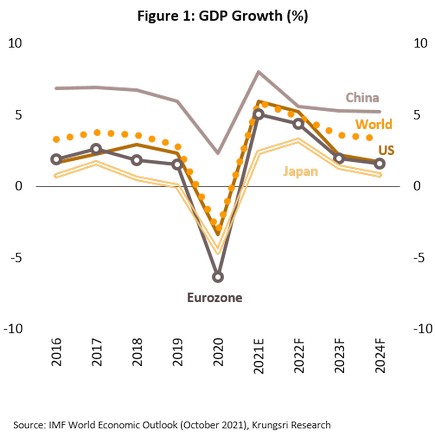
- US economy is predicted to enjoy average growth of 3.0% per year over 2022-2024, and so although the rate of expansion will drop from 2021’s 6.0% as the positive effects of stimulatory fiscal and monetary policy and the reopening of the economy dissipate, the outlook remains positive. With unemployment at 4.2% in November 2021 compared to 14.8% in April 2020, labor markets have clearly made significant strides towards recovery, lifting incomes and boosting consumer spending, while in the business sector, investment is rising with stronger demand on domestic and export markets. The economy will further benefit from President Biden’s infrastructure spending plan and the injection of USD 1.2trn into the economy over 2022-2029, while the recent agreement to implement a global minimum tax, effective from 2023, may help to accelerate reshoring. Internationally, tensions with China are likely to persist and the setting up of the ‘Build Back Better World’ as a US competitor for China’s Belt and Road Initiative will intensify competition over access to business partners, with the result that divisions between those embedded in US-oriented and China-oriented value chains can be expected to become much clearer. On the policy front, the Fed will unwind its monetary stimulus, initially through the commencement of QE tapering at the end of 2021, before lifting policy rates in 2022. However, Fed dot plots indicate that 2024 policy rates may remain lower than Fed’s long-term interest rates forecast of 2.5%, and so the expectation is that monetary policy will remain relaxed and supportive of continuing economic recovery.
- Eurozone growth should average 2.6% per year through the next 3 years, after reaching an estimated 5.0% in 2021. The main drivers of growth will be consumption, investment and tourism. The first of these, consumption, will be lifted by recovery in labor markets and a rebound in spending power, itself boosted by an increase in savings during the COVID-19 pandemic. Investment will benefit from the EU Recovery Fund, which is now steadily making allocations that will contribute to many country’s plans for job creation schemes and this will potentially add 0.7-1.0% annually to Eurozone GDP. The tourism sector will also recover, though this will mostly benefit countries in southern Europe (e.g., Spain, Italy, and France). Additional help will come from interest rates that are expected to remain low through to at least the end of 2022, while relaxed monetary policy will continue to support liquidity, although the likely termination at the start of 2022 of the Pandemic Emergency Purchase Programme, which has an asset purchase ceiling of EUR 1.35trn, will mean that its scale will not match that maintained through the pandemic. The Eurozone will, though, face headwinds. Semiconductor shortages should begin to ease in the latter half of 2022 but until then, this will weigh on manufacturing and exports, while the reintroduction in 2023 of EU rules that specify a ceiling on government debt of 60% of GDP and a limit on budget deficits of 3% of GDP may restrain plans to increase investment in countries facing fiscal difficulties. Interest in environmental issues is also building worldwide, but this is particularly notable in Europe, where campaigns to cut investment in fossil fuels and to use clean energy that supplies are currently limited may combine over the short term with the reopening of economies to generate energy shortages and to feed rising inflation.
- For the Japanese economy, growth is likely to be limited to an average of 1.8% annually, down from 2021’s 2.4%. The economy will be the beneficiary of several factors. (i) Exports will continue to expand to serve with recovery in the world’s trade and economy. (ii) Investment will rise to meet the expansion of export and to broaden technological uptake as the country tries to overcome gathering problems with labor shortages. The tourism and related industries will also benefit from the reopening of the country and the ‘Go To Travel’ scheme. (iii) Labor market is improving, as reflected in October 2021’s unemployment rate of just 2.8%. This will then support higher household consumption. (iv) To counter the effects of COVID-19 and to help stimulate the economy, the authorities will inject another JPY 30trn (worth 5.6% of GDP) into the economy. At the same time, the government is pushing forward with its ‘new capitalism’ doctrine. This aims to rebalance economic policy by allocating the benefits of growth more fairly, for example by raising taxes on high-income earners, increasing wages, and promoting greater investment in regional economies. For its part, the Bank of Japan (BOJ) is expected to stay the course with relaxed monetary policies that include negative interest rates, yield curve control (YCC), and quantitative easing, but despite this, recovery will be slow, a situation that will be amplified by the high household savings rate, widespread deflationary mindset, and continuing consumer hesitancy over expenditure.
- For China, growth will decelerate from 2021’s 8.0% to a forecast 5.4% over 2022-2024. In the coming period, economic growth will be held back by the government’s determination to focus on long-term issues and to crack down on speculative pressures, excessive profits, monopolistic practices, and the unbalanced real estate sector. In addition, the government is continuing with its zero-Covid strategy, and this will inevitably delay the reopening of the country. At the same time, though, major drivers of the economy will include the following. (i) Exporters and related parts of the economy will benefit from the rebound in world trade and the strengthening of the global economy, their advantages in manufacturing technologically-based products, and the conclusion of the RCEP and CPTPP agreements. (ii) Household consumption will be lifted by recovery in labor markets and by the government’s ‘common prosperity’ policy and its focus on reducing inequality (e.g., by implementing measures to help small businesses take on new hires and to reduce the cost of living for low-income earners). (iii) Policies to increase investment in technological innovation, environmental protection, and the buildout of new infrastructure will help the economy further, as will greater efforts to reduce the risk of the economy facing future disruptions to manufacturing by raising national self-sufficiency and developing stronger domestic supply chains. (iv) Domestic tourism will benefit from the government’s inward-looking policy of economic growth, which it is adopting as a way of reducing the impacts of turbulence in the world economy and the spread of COVID-19. (v) In terms of economic policy, the Chinese authorities are adopting a ‘cross-cyclical approach’ that makes gradual adjustments to both fiscal and monetary tools, while keeping its focus on long-term trends. These include, for example, the use of targeted policies to stimulate growth in the real economy. These factors will then help the Chinese economy grow steadily, even if the rate of growth slows somewhat from the levels seen in the past.
Structural changes to the world economy…long-term impacts for business and industry
- The structure of the world economy is changing as it continues its transition from a dependency on manufacturing to being largely focused on services; the share of global GDP generated by the service sector rose from 60.4% in 2008 to 64.3% in 2019. In developed economies, this share is generally much higher and around 75% of US and UK GDP comes from services, mostly from modern services such as IT/software and finance. In Thailand, services comprised 58.3% of the economy as of 2020, up from 50.4% in 2008 (Figure 2) but unlike developed economies, traditional services that generate only low levels of added value predominate (e.g., tourism, trade, hotels, and restaurants). By contrast, only 14% of Thai GDP comes from high value-added modern services, which tend to be concentrated in the areas of finance and telecoms.
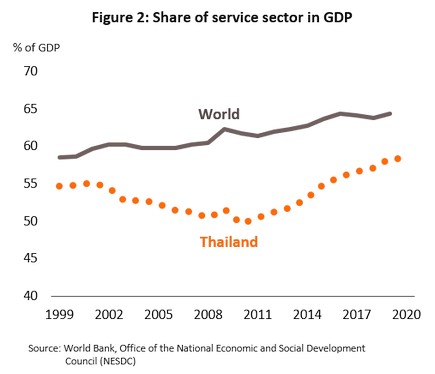
In the coming period, there is an opportunity for the service sector to increase its contribution to Thai GDP thanks to the growing application of new technology and innovation within the sector, for example through the development of online platforms that provide access to global tourist sites, and the development of robotic and remote surgical systems. At the same time, the manufacturing sector is also turning to “servicification” to add greater value to their products and to widen product differentiation. By using artificial intelligence and big data analytics to improve designs and to offer advice, companies are able both to increase their sales and to manufacture new products that respond more directly and more accurately to consumer needs, and these trends are then raising the importance of services in Thai supply chains. However, bringing the contribution of services to GDP of Thailand up to the level of developed economies will be difficult because (i) the service sector and related businesses (e.g., hotels, restaurants, real estate, and construction) have been badly hurt by the COVID-19 crisis, and (ii) compared to those of developed economies, Thai regulations and policy are relatively unwelcoming to foreign investment in the service sector, as is reflected in Thailand’s ranking of 46 out of 48 in the World Bank’s 2020 Services Trade Restriction Index. The existence of these high barriers to entry means that it is difficult to bring new investment and technology into the sector, and this represents a significant obstacle to the further transition to the provision of modern services. This is a challenge for Thailand to transform service sectors into modern services amid a gradual economic growth.
- Modern technology is transforming the structure of the manufacturing and service sectors broadly and rapidly. This wave of the digital revolution, which is now carrying the whole world along, is helping to generate value creation for manufacturing and service sectors to increase the sustainability of growth and adding to the security of supply chains. Over the next 3 years, some of the more important technological developments to affect the economy will include the following.
- The Internet of Things (IoT): IoT will have a greater role to play in gathering data related to everyday activities from sensors placed in devices including medical equipment, electrical appliances, and auto equipment. The number of IoT applications is steadily increasing, and this is now used by, for example, smart hotel rooms that allow occupants to control the room’s electrical devices through their own mobile phone, and companies that use IoT technology to track and manage goods deliveries.
- Robotics: The use of robots or other machines that are able to carry out precision work and to operate autonomously is reducing losses in manufacturing and increasing work safety. These machines are equipped with onboard software, microprocessors and sensors, and are particularly suitable for use in repetitive tasks, such as transporting dangerous loads in the electronics or construction industries, welcoming guests to hotels, planting crops, and feeding livestock.
- Artificial Intelligence (AI): When AI is used in industry, it is often combined with other technologies such as cloud computing and IoT for use in big data analytics or to develop “cobots” (robotic systems that work alongside humans) that are deployed in, for example, the auto and electronics industries. Use cases for AI include controlling production processes to reduce waste, and predicting optimum maintenance schedules for equipment. AI is also used in medicine to help with diagnosis and pattern recognition, for example in tracking COVID-19 infections, while real estate developers use AI to design buildings.
- 5G technology: This is used to develop networks that allow the work of different machines to be integrated efficiently, cutting labor costs, reducing work times, and slashing manufacturing waste. For example, the Japanese HIROTEC Corp. is using 5G networks to manage the remote control of machines producing auto parts, while the German company MTU Aero Engines is using the technology to help with the design of airplane engines, and in the process it has cut costs by 75%.
- Drones: Drones (pilotless aircraft controlled from a distance) are reducing companies’ dependency on labor and cutting the time taken to survey land, especially in agricultural contexts, where they are being used at all stages, from planning planting schedules through to the harvest. Agricultural drones are also being used to find and track livestock and to spray chemicals, while in the real estate sector, developers are using drones to measure or survey land, especially when doing so in person would be dangerous.
- Blockchain: Blockchains are a means of storing data on distributed ledgers that are accessible to those within a network but with access to this network potentially restricted by the use of passwords. This is a secure way of storing information, and is being used in finance to develop digital assets, in agriculture to maintain supply chain and provenance transparency, and in logistics where, combined with cloud computing, blockchains are used to track deliveries.
- Edge computing: This involves making real time adjustments to manufacturing processes through the application of big data analytics and live information on consumer demand, thus allowing companies to make extremely rapid responses to changes in consumer behavior. Applications of edge computing are currently most often found in health, recreation and transport industries, though it is also used in logistics planning to evaluate climatic conditions and to assess the likelihood of accidents occurring.
- Quantum computing: The switch from binary digital computing to computing systems that take advantage of quantum indeterminacy will potentially lead to an enormous expansion in computational power and speed, adding enormously to the abilities of AI systems. Commercial applications of quantum computing are beginning to emerge, especially in the area of smart devices (e.g., robots and self-driving vehicles).
- 3D printing: Advances in 3D printing technology now allow for the rapid, low-cost design and production of a huge range of products. 3D printing is increasingly being used in manufacturing supply chains connected to the development of auto parts and in ‘recycle bots’ (recycling old 3D printed objects into new products), such as in the production of auto and aircraft parts, electronics equipment, medical devices and dental implants. 3D printing is also being used in the construction sector for the rapid design and building of new structures.
- Synthetic biology: The most common application of synthetic biology is in the production of synthetic meat such as ‘cultured meat’, which is grown from stem cells from the target animal (i.e., from cows, chickens, pigs and tuna), and ‘plant-based meat’, made from plant products that has the taste and texture of real meat. These products reduce exposure to some of the health risks related to meat consumption and provide an alternative source of meat in the event of outbreaks of livestock disease. They also provide a way of meeting demand from the growing number of older consumers.
- Data analytics: This entails the systematic analysis of big data to help companies offer goods and services that better meet customer demand. For example, data analytics is used in the tourism sector to analyze historic data to make better predictions about demand growth or to recommend personalized packages to potential travelers.
- Global value chains are shortening, and this is adding to competitive pressures for industry. The major economic powers are continuing to erect and maintain barriers to trade, as well as increasing their self-reliance and competing through the development of new technology in upstream industries. These events are partly a result of the COVID-19 crisis and the subsequent stalling of production lines, as seen in the production problems that many auto assemblers are facing due to the global chip shortage, and in light of this, corporations are increasingly turning to sources of inputs within their home region, causing global value chains to shrink at an accelerating rate. As trade channels narrow, competitive pressures are also rising (Figure 3), and in this environment, the broadest range of opportunities will be presented to countries that produce either upstream goods (the starting line for the production process) or downstream products (its ending line), where players are able to produce the greatest added value for global value chains. Countries in this group include the US, the EU and China (World Bank, 2020). However, as competition stiffens, players in the middle of the race that manufacture midstream products, often doing so on order in industries such as electronics, computers and auto assembly, will have to contend with narrowing opportunities to add value through the production process. Manufacturers in this less favorable part of the value chain will therefore need to consider their position and if possible, move further to its extremities, going either up- or downstream as appropriate. Analysis by Krungsri Research indicates that of the industrial sectors important to the Thai economy, players in auto assembly, computer manufacturing and petroleum refining should move upstream, whereas those in the production of electronics and machinery would do best by moving downstream (Figure 4). To achieve this, it may be necessary to build alliances with countries that already compete strongly and effectively in world markets. Doing so would then allow Thai players to add additional value and to establish a sustainable place on global supply chains (for further details please see Thai Industry: How Competitive is Thailand on the World Stage?)
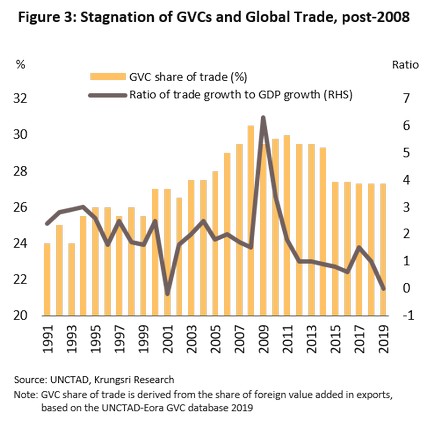
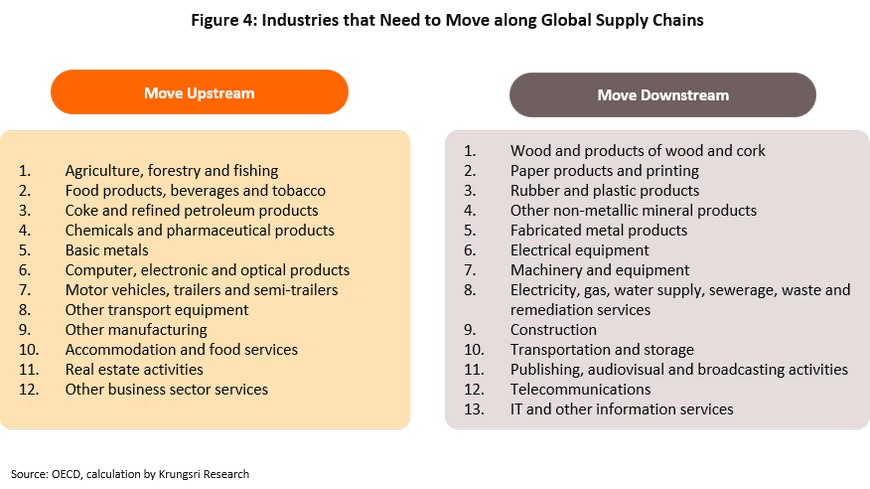
- Integration of global trade is increasingly tending to take the form of regional trade blocs, such as the Regional Comprehensive Economic Partnership (RCEP) and the Comprehensive and Progressive Agreement for Trans-Pacific Partnership (CPTPP). The latter has 11 members, namely Japan, Canada, Mexico, Peru, Chile, Australia, New Zealand, Singapore, Malaysia, Brunei and Vietnam. At present, Thailand has no obvious intention to join the CPTPP, mainly because of worries about anti-monopoly rules that would affect in particular the agricultural and pharmaceutical industries. On the other hand, the RCEP agreement has 10 ASEAN members and a further 5 countries that trade with the ASEAN region, namely Australia, China, Japan, New Zealand, and South Korea. The agreement has now been fully ratified[1] and so this will come into effect on 1 January, 2022. Member states have agreed to cut tariffs on around 90% of goods over a 10-20-year period, though reductions will move in step with each country’s readiness for this. Krungsri Research’s assessment of the agreement is that for Thailand, joining RCEP will benefit sales of fresh and processed fruit, fisheries products, rubber products, tires and tire products, plastics, chemicals, components for electrical goods, and computers and computer parts. The total effect of the proposed tariff reductions is not, however, expected to be dramatic since all RCEP members already have free trade agreements with Thailand. Nevertheless, over the long term, the agreement will help to increase security for Thai players embedded in regional manufacturing supply chains, in particular those where Thailand is already competitive and has a strong production base (especially in auto and auto parts manufacturing, petrochemicals, and plastics). Beyond this, over the next few years, the significant size of the RCEP market will help to bring advantages to members through their greater connection to global supply chains[2] (Figure 5).

The Thai economy 2022-2024: An export driven recovery, helped by a cyclical rebound in investment
The Thai economy is expected to see average annual growth of 3.7% over the next 3 years. A gradual recovery will begin in the last quarter of 2021 (Figure 6) and this will be supported by a number of factors. (i) The progress of the vaccination program means that the COVID-19 crisis is beginning to pass and this is allowing the domestic economy to recover. In addition, widespread changes to behavior and the adoption of the ‘new normal’, combined with rapid advances towards digitalization, are also stimulating greater demand for goods and services among groups affected by these developments. (ii) The Thai tourism sector will gradually recover with Thailand’s reopening to foreign arrivals at the end of 2021, although the persistence of strict controls in some originating countries and uncertainty over the possibility of new outbreaks will continue to weigh on the sector, and it will not be until 2025 that arrivals will return to their pre-pandemic level. (iii) Exports are continuing to grow and recovery in demand globally, and in particular export markets, will combine with the trend to greater regionalization of trade to ensure that the export sector will be a major driver of economic growth for Thailand in the coming period. An especially notable example of regionalization is the RCEP , which is enforced from the start of 2022, helping to boost trade in the coming period. Despite this rosy outlook, exports will nevertheless come under pressure from supply problems, which may take the form of either shortages of raw material or higher costs, or the periodic imposition of barriers to trade. (iv) Private-sector investment will tend to rise on a combination of cyclical economic recovery and the increase in production needed to support greater digitalization. Investment will also benefit from stronger government spending on infrastructure megaprojects. (v) An additional lift to the economy will come from government stimulus that will include both regular budgetary expenses and disbursements made from what remains of the THB 500bn raised from emergency borrowing. On the monetary side, the Bank of Thailand is expected to keep policy rates at their historic low of 0.5% through to at least the end of 2022, and to leave in place help that includes measures to restructure debts and increase liquidity for household and business debtors. Regulations will also remain relaxed to ensure that assistance is made available to debtors, while the temporary easing of LTV rules will provide a further stimulus to real estate markets.
However, while the outlook is for growth over the next few years, negative factors will continue to drag on the economy, including fragility in labor markets, and rising household and corporate debt, which may then hold back increases in spending. Other risks and uncertainties could arise from possible further mutations in the COVID-19 virus or from domestic political tensions that may lead to discontinuities in government policy. Domestic and global financial markets may also have to contend with an increase in turbulence and a hike in the cost of finance, potentially unwanted side effects of the scaling back of stimulus measures and policy normalization in the major economies.
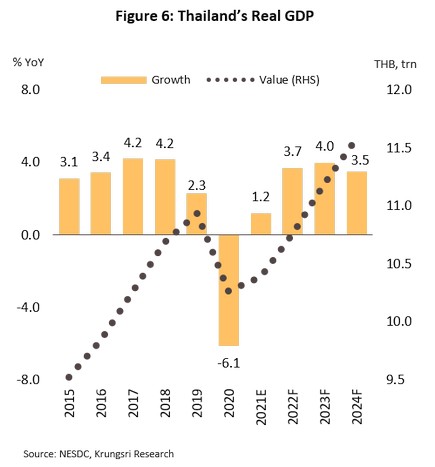
Infrastructure investment…a major driver of overall domestic economic growth
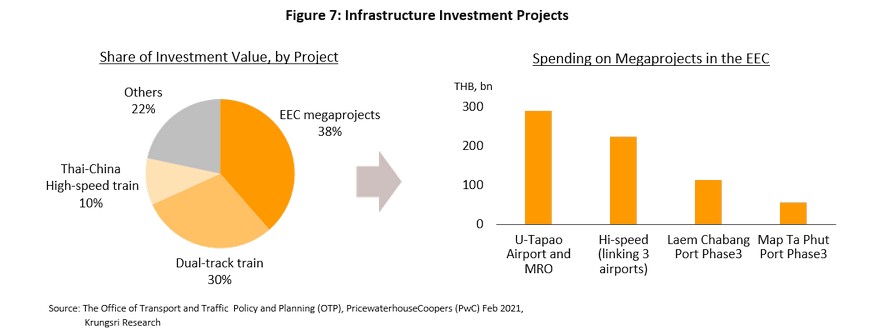
Over the next 2-3 years, an acceleration in spending on government-backed megaprojects will provide an important boost to the economy (Figure 7), though this will be particularly the case for spending on the Eastern Economic Corridor (EEC) since this will help to pull in additional foreign direct investment (FDI). In the coming period, notable government infrastructure projects will include the high-speed rail-link connecting the three airports in the Bangkok region, the development of U-Taphao Airport and the Eastern Airport City, phase 3 of the Laem Chabang Port development, and phase 3 of the Map Ta Phut Port expansion. Phase 2 of the development of the EEC is also scheduled for 2022-2026, and with a budget of THB 2.2trn, this is more valuable that phase 1’s allocation of THB 1.7trn for work carried out over 2018-2021. The government has also said that work on several important developments will take shape in 2022. Most important among these will be the Gulf of Thailand-Andaman Sea land bridge, which will provide logistics support linking the EEC with the Southern Economic Corridor (SEC).
Additional work that will take place on the nation’s communications networks over 2022-2024 will follow the 2018 Transport Action Plan, itself bound by the 20-year strategy for the development of the national transportation system (2018-2037). This will include the following:
- Rail: New rail projects will include the Bangkok-Nakhon Ratchasima high-speed rail line (part of the Thailand-China line), which has been divided into 4 contracts covering around 80 kilometers, phase 2 of the dual-track Khon Kaen-Nong Khai line (167 kilometers), and the Purple Line (South) Tao Pun-Rat Burana extension (23.6 kilometers).
- Road: The Bang Khun Tien-Ban Phaeo section of the M82 motorway will have a length of 16.4 kilometers
- Other infrastructure development: Bidding for work on the development of Terminal 2 on the northern side of Suvarnabhumi Airport (able to handle 30m travelers per year) is scheduled for 2022 and it is hoped that work will be completed by 2024. Selecting contractors for phase 3 of the development of Don Muang Airport should be completed no later than the end of 2021, and work is expected to last 2 years, allowing for services to begin in 2024.
If those infrastructure project investment can be operated as planned, this will help to open opportunities for investment in downstream and related industries across the region. This will be particularly the case for investment in the production of electrical vehicles (EVs), modern medicine, smart electronics, digital technologies, and modern agriculture and future food industry.
The industrial environment
Structural problems are eroding the competitiveness of Thai industry
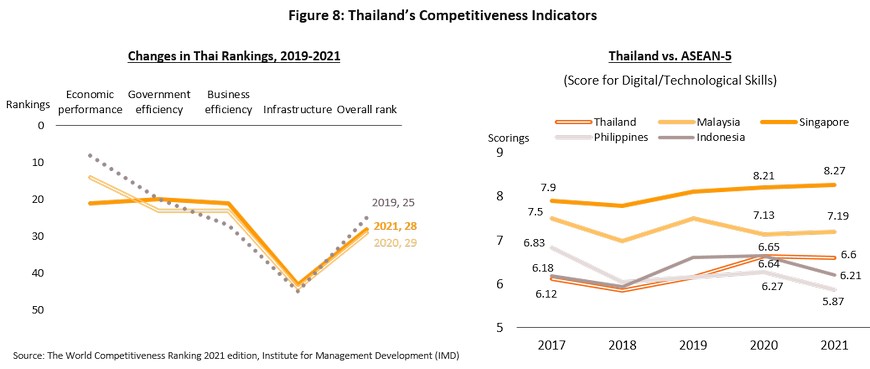
In the 2021 IMD World Competitiveness Ranking, Thailand achieved a ranking of 28, almost unchanged from 2020’s 29th placed position. Although the country was able to improve its position in government efficiency and business efficiency, the COVID-19 pandemic has had severe consequences for the tourism sector and this then affected Thailand’s position for economic performance, pulling this down 7 spots to 21st place (Figure 8). With regard to infrastructure, Thailand has made a slow progress, and although the country is ahead of Indonesia and the Philippines for technology and digital skills, it remains significantly behind Singapore and Malaysia. Thailand’s labor force is short of skilled workers in these areas, which then limits the ability of companies to innovate and develop new intellectual property. In the coming period, this will thus also affect the development of the manufacturing and service sectors. On spending on research and development, Thailand also performs poorly, and the country allocates just 1.14% of GDP to R&D (Figure 9), the lowest rate among its competitors in Asia indicating that it will take an extended period of time to develop the ability of Thai players to generate goods and services value creation through innovation for competing in global market, especially compared to the 5 countries with the most competitiveness including Switzerland, Sweden, Denmark, the Netherlands and Singapore, all of whom drew strengths from their investments in innovation, digitalization, the provision of welfare benefits, and social cohesion.
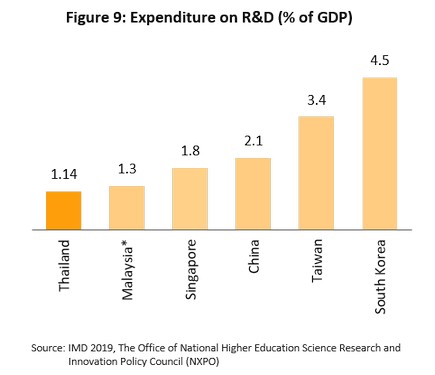
Changes to the regulatory environment that may affect Thai industry
Real estate
- Rules governing the real estate sector are currently under review, with the aim being to make purchases of land and property in Thailand more attractive to overseas buyers and to increase confidence among long-term foreign residents of the country. These changes include the following.
- The land code: An amendment to the land code may allow non-Thais to own residential property in gated communities with a value of THB 10-15m and over, provided that not more than 49% of the land on any community is owned by non-Thais. The earlier law, specified under section 96 bis of the land code, allows non-Thais to buy land for residential use provided that they have invested at least THB 40m in Thailand, they are buying no more than 1 rai of land, and they have the permission of the relevant minister.
- The Condominium Act: A proposed amendment to the law would allow non-Thais to own more than 49% of the area for sale in any given condominium building but they would not have a right to a vote in the building’s management committee (the 2008 Condominium Act (4th Amendment) permits non-Thais to own condominiums provided that no more than 49% of the area for sale within the building is owned by non-Thais.)
- Renting properties to non-Thais: A proposed amendment to the law would extend the maximum length of leases made to non-Thais to 50 years, with an extension of 40 years then also possible (Article 540 of the Civil and Commercial Code permits leases and extensions to these to be for a maximum of 30 years).
Manufacturing
- Tax on the sugar content of non-alcoholic drinks: This tax has been introduced with the aim of increasing public awareness of the dangers to personal health of consuming excessive amounts of sugar. The tax is being introduced in 4 phases. Phase 1 ran from 16 September, 2017-30 September, 2019, phase 2 is running from 1 October, 2019-30 September, 2022, phase 3 will run from 1 October, 2022-30 September, 2023, and the final phase will run from 1 October, 2023, onwards. The enforcement of this tax may encourage some producers to sell drinks with a lower sugar content or to focus more on health drinks.
- New royal decrees governing regulations in a range of industries. New regulations are being enforced across the economy to bring standards up to date. In construction and civil engineering, this has included rules on Portland cement (effective 15 March, 2022), low carbon wire (effective 27 February, 2022) and hot-rolled steel (28 May, 2022); in electrical goods and electronics, this includes rules on fittings and starters for fluorescent lights (28 January, 2022), energy-saving washing machines (27 February, 2022), and LED lights (29 March, 2022); and for food processors, it includes rules on selling pineapples in sealed packaging (16 January, 2022). As companies move to meet the requirements of these new regulations and so raise standards and improve safety, they will be forced to upgrade and modernize their technology and production processes, but this will then help to increase opportunities for players to access domestic and overseas markets.
Energy and the environment
- The plan for the transition to a carbon-neutral economy (expected to come into effect in 2023) is composed of: (i) the Power Development Plan (PDP 2022); (ii) the Gas Plan; (iii) the Alternative Energy Development Plan (AEDP); (iv) the Energy Efficiency Plan (EEP); and (v) the Oil Plan. The implementation of this will likely increase investment in businesses active in electricity production, natural gas production and importation, and oil refining.
- Changes to the energy sector will include the following:
- As laid out in PDP2018 (rev. 1), renewables generating capacity will be increased, while the share of electricity coming from fossil fuels will fall over the 10 years between 2021 and 2030. As part of this, support will come for power plants running on biomass or biogas and for waste-to-energy schemes, the market will be fully opened to supplies of power from roof-top solar installations, and to help balance supply of alternative energy, investment will be encouraged in the technology needed to store energy. Overall investment in electricity generating companies will therefore tend to accelerate from 2022 onwards.
- The electricity transmission system will be overhauled to increase its flexibility and to extend its reach into areas that have high potential as sources of alternative energy, allowing for a general expansion in the supply of power generated from renewables.
- The market for the importation of LNG will be fully opened, allowing new private-sector players to source and ship LNG (at present, only a few permits for this are issued). This is then expected to lead to lower domestic prices for natural gas.
- The plan to end financial support for biofuels (gasohol E20 and E85, and diesel B10 and B20) has been postponed to 2024 from 2022, in light of the fall in demand for energy that COVID-19 has triggered, the authorities wish to avoid inflicting further harm on ethanol producers and palm growers.
- The introduction of tighter regulations on vehicle exhausts (part of plans to reduce PM 2.5 pollution) have been postponed. Originally, the Euro 5 and Euro 6 regulations were scheduled for introduction in respectively 2021 and 2022, but this has now been pushed back to 2024 and 2025; the development of the new engines that will be needed was judged to be too costly at the moment.
- The Building Energy Code (BEC) lays out fresh energy-saving requirements that cover the design and construction of new buildings. The BEC will affect 9 types of structure: clinics and hospitals, offices, apartment buildings, meeting halls, theatres and cinemas, hotels, bars and nightclubs, educational institutions, shopping centers and department stores. For buildings with a footprint of 10,000 sq.m. and over, the BEC has been enforced from 2021, while for those with sizes greater than respectively 5,000 and 2,000 sq.m., the new rules will be enforced in 2022 and 2023. This will then raise costs related to design, construction and renovation.
Tourism
- Promoting domestic tourism
- The annual THB 40/room registration fee paid by hotels is being suspended (1 July, 2020-30 June, 2022) to reduce the financial burden on hoteliers already suffering from the COVID-19 crisis.
- The government has delayed the implementation of rules on the regulation of buildings offering hotel-type services, and operators of hotels and other types of accommodation will now have until the end of 2024 (not 2021) to make any alterations required by these regulations. These companies can also offset any expenses incurred in this against their tax to twice its value and they may also participate in government-run tourism promotion campaigns, while hotel guests are likewise able to set their hotel expenses against personal tax. Out of Thailand’s total of around 40,000 incorrectly registered providers of accommodation services, some 20,000 requested temporary waivers to the requirement to make alterations to their buildings, and this should help to increase fair competition on price, and the hotel occupancy rate should better reflect real demand.
- The relaxation of COVID-19 control measures will help to stoke recovery in the tourism sector, and from 1 January, 2022, fully-jabbed tourists who meet certain requirements will be able to enter the country quarantine-free.
Finance
- THB 250bn in soft loans has been made available to SMEs that are financially troubled but that remain fundamentally viable. Earlier regulations on soft loans have been relaxed further and credit extended to both new and existing debtors, with repayment schedules extended and collateral rates raised for risky debtors. At the same time, the government has lowered or waived business taxes and fees, and the Bank of Thailand has provided low-cost liquidity to lenders to help them release more credit to businesses and to increase access to loans for at-risk borrowers (this began in February 2021).
- THB 100bn has been allocated to support an asset warehousing scheme. The scheme provides help for sound businesses that have been badly affected by the COVID-19 crisis and that are facing a long, drawn-out recovery (in particular players in the tourism sector) but that have access to transferrable assets; the asset warehousing scheme allows these businesses to temporarily set these assets against their debts. This then means that for as long as the assets are warehoused, debtors will be spared repayments on the loan principal and interest. Businesses participating in the scheme have the option of renting their assets back again, if they need them to carry on their business, or of temporarily shuttering operations completely. Warehousing assets in this way offers the advantages of preventing a flood of unwanted assets entering the market simultaneously and so prompting fire sale discounts, and of allowing operators the option of buying their assets back again, once the business environment has improved. For its part, the government has also waived or cut taxes and other charges related to this procedures, and the Bank of Thailand has supported the program by providing low-cost funding to financial institutions equivalent to the asset-transferred price, as agreed by financial institutions and borrowers.
- Assistance to SME and corporate debtors has included debt restructuring and the establishment of the Corporate Bond Stabilization Fund (CBSF), though as yet, no applications for funding from this have been made.
- Regulations have been relaxed for retail debtors with regard to supervised personal loans, credit card debt, and digital personal loans. This will help to ease the burden of repayments and to temporarily increase liquidity (this program runs from 19 August, 2021, to 31 December, 2022).
- Required contributions to the Financial Institutions Development Fund have been cut from 0.46% to 0.23% for 2 years, beginning in April 2020.
- Plans have been made to prepare financial institutions for future change. These have included: issuing rules for the use of alternative data when offering and issuing digital personal loans (with effect from 15 September 2020); the Payment Systems Roadmap (2019-2021), which emphasizes the use of digital payments as the preferred payment method; and the issuing of rules for the operation of peer-to-peer lending platforms (with effect from July 2020).
- Rules governing the issuance of mortgages and related loans (i.e., LTV rules) have been eased for loans issued between 20 October, 2021, and 31 December, 2022. These changes raised the ceiling on the value of these loans (the LTV ratio) to 100% of the value of the loan collateral (i.e., mortgages may temporarily be taken out that cover the full value of the property being purchased) when these loans are for the purchase of a house, or when the loan is for other purposes but it is secured against a property, or it is a top-up loan. This applies when: (i) the value of the collateral is less than THB 10m and the loan is being made for a second (or more) home; or (ii) the value of the collateral is greater than THB 10m, and the loan is being made for a first (or more) home. These measures have been introduced to stimulate housing markets and related parts, that have combined share of 9.8% of Thailand’s GDP.
Others
- The Ministry of Commerce has banned the import of second-hand motorcycles (including those powered by internal combustion engines, electrical motorcycles and bicycles, and sidecars). These rules will come into effect in February 2022 and will have a negative impact on importers as well as on the broader market for second-hand motorcycles and related industries, e.g., those providing maintenance services and distributors of second-hand parts.
- To allow their growing and processing, the authorities have removed three plant products (hemp, cannabis and kratom) from the list of illegal narcotics. This will now allow for an increase in added value for products derived from these and an expansion in downstream industries.
Krungsri Research believes that the features of the macroeconomic and business environments outlined above will present businesses with both opportunities and threats, and in responding to this situation, players will need to be quick to adapt themselves to evolving economic and social contexts and to a changing regulatory regime. Doing so will allow companies to put down the foundations needed to support the construction of an environment conducive to long-term, sustainable growth.
AGRICULTURE
Rice
Situation in 2021
- Over 10M21, production index of paddy increased 7.7% YoY on the greater availability of water and more favorable climatic conditions from 2H20 onwards. This combined with the government’s income guarantee scheme to encourage farmers to extend the area cultivated or to increase cycle of plantations. However, price index for paddy slumped 18.7% YoY with a sharp fall in the price of both jasmine and glutinous rice. This was a result of: (i) an oversupply of rice in 2021 that then depressed prices; and (ii) strong competition in world markets, which also undercut prices. Given this, overall income index for rice growers slipped 12.5% YoY in line with lower prices.
- Export volume inched up 1.4% YoY to 4.6m tonnes in 10M21 after it shrank 31.0% YoY during the first 5 months owing to high cost of Thai rice. A rise in volume was supported by a sharp decrease in rice prices (relative to Vietnam, India, Pakistan and China). However, export value fell 13.2% YoY to USD 2.6bn following lower rice prices.
- Outputs in Q4 (when 80% of the main crop is harvested) are expected to rise on (i) favorable weather and rainfall, and (ii) the government stimulus measures to support and earlier high prices, which encouraged farmers to expand the area planted/number of plantings. For 2021 overall, total paddy outputs are forecast to rise 4.4% to 29.9mn tonnes, while falling prices for Thai rice in 2H21, which could enhance Thailand’s competitiveness, is expected to lift exports by 4.6% to 6.0m tonnes.
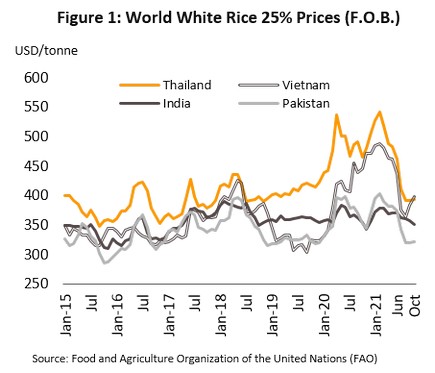
Outlook for 2022-2024
- The forecast is that annual outputs of paddy is forecast to increase 1.5-2.5% to 30.3-31.3 m tonnes, yielding 19.7-20.3m tonnes of milled rice. helped by (i) likely favorable weather conditions and rainfall (over 2022-2023, crops may continue to benefit from La Niña conditions), which would allow greater access to irrigation water; (ii) the government’s subsidy measures to help farmers and stabilize the rice market, which include income guarantee schemes, crop insurance, help with planting plans, pledging schemes that help slow the release of the new crop to the market, and plans to balance the rice industry and to provide the agricultural sector with sufficient irrigation water.
- Domestic demand is expected to grow to 10.7-11.1m tonnes per year, helped by the easing of the COVID-19 crisis and the reopening of the country to tourism, which will then support stronger demand from food processors, restaurants, hotels and other downstream industries.
- Exports would average 7-8m tonnes annually, with demand especially strong from South Africa, the US, China, Benin, and Japan.
- Export prices will tend to remain close to the low level seen in 2021, held down by anticipated strong outputs in Thailand and high stocks of rice worldwide.
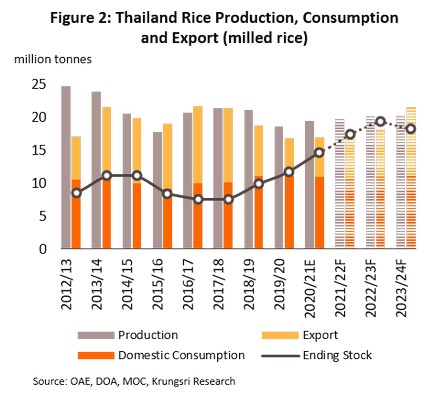

Rubber
Situation in 2021
- In 9M21, the index of natural rubber production rose 4.9% YoY, boosted by higher prices and government income guarantee schemes incentivize farmer to tap the rubber. Exports also strengthened, climbing 3.6% YoY to 3.5m tonnes on higher demand for TSR and RSS from tire, autos and auto parts manufacturers in China, where domestic stocks of rubber have fallen, and for latex from surgical gloves and medical devices. This underpinned a 29.2% surge in export prices, which pushed up export value by 33.9% YoY to USD 6.0bn. Domestic demand also increased from downstream industries (autos, auto parts, surgical gloves and rubber medical devices) and government support through increasing purchases by state bodies.
- In the final quarter of 2021, both production and sales of rubber will tend to improve and for the year overall, output of intermediate rubber products is expected to rise 3.0-4.0% to 4.6m tonnes. As regards overseas sales, although a shortage of container space and high freight charges are weighing on the industry, the forecast is that exports will climb 8.0-10.0% to 4.8-5.0m tonnes, helped by: (i) stronger demand from China, Malaysia, Japan and the US; (ii) reducing supply from competitors especially Indonesia and Malaysia that faced persistent problems with outbreaks of leaf fall disease and labor shortages of rubber tapping workers. Export prices are also expected to jump 20.0-30.0% on strong demand and still-high prices for commodities generally, though especially for crude, and given this, the export value will climb by 30.0-35.0% to USD 8.2-8.4bn. Domestic sales should rise by 3.0-4.0% on greater demand from downstream industries and increasing purchases of rubber by state bodies.

Outlook for 2022-2024
- Rubber outputs are predicted to increase at an average annual rate of 3.0-4.0%, supported by (i) the earlier expansion in plantation sizes, and (ii) stronger demand in domestic and export markets and subsequent higher prices.
- Demand will tend to increase, and domestically, the market is expected to expand by 3.0-4.0% annually as the economy rebounds and progress is made on infrastructure projects, generating greater demand for rubber in downstream industries. Exports should also increase by 2.0-3.0% per annum, supported by a recovery in downstream industries, including autos and auto parts, surgical gloves and medical devices, and the manufacture of sanitary and healthcare products connected to the aging of society.
- RSS and TSR: Exports should increase by respectively 1.0-2.0% and 2.0-3.0%, helped by (i) recovery in the auto and auto parts industries, and (ii) the rebuilding of rubber inventories.
- Concentrated latex: Exports are predicted to edge up 1.0-2.0% but the rate of increase will be limited by the high baseline set in 2021 and competition from competitor nations (i.e., Indonesia and Malaysia), which will begin to recover.
- Compound and mixed rubber: Exports would expand by 1.5-3.0% on growth in the electronics, construction, transport, petroleum and chemical industries.

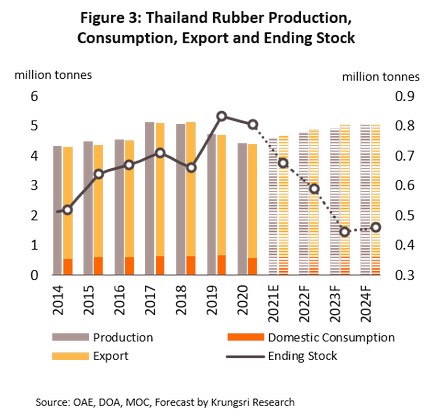
Cassava
Situation in 2021
- Over 10M21, the fresh cassava production index rose 8.7% YoY on: (i) an expansion in the area under cultivation, itself helped by (i.1) prices for cassava that have been rising since 2H20, and (i.2) government support for growers, provided in particular through the income guarantee scheme; and (ii) rainfall and irrigation water that were sufficient to support the area under cultivation. Exports of cassava products also performed well in the period.
- Exports of cassava chips and cassava pellets (43.0% and 0.2% share of totals respectively) jumped by respectively 59.3% and 45.8% YoY, mostly due to stronger purchases from China driven by: (i) increased demand as a replacement for corn (which is now more expensive) for use in the production of alcohol and ethanol; and (ii) the abating of disease outbreaks in swine herds and chicken flocks, leading to improving demand for use in animal feed production.
- Exports of native (39.0% share) and modified starch (14.6% share) rose by 33.8% YoY and 15.0% YoY, respectively. Demand was again lifted by the Chinese market, especially in downstream industries including food and beverage processing, paper, glue, textiles, chemicals, fiberboard, pharmaceuticals and cosmetics.
- Demand should continue to strengthen in the remainder of the year, and for 2021 overall, the total output of fresh cassava is estimated to hit 30.1m tonnes, up 3.8% (6.7% drop in 2020). Domestic demand would increase by 1.8% (down from 2020’s growth of 4.6%) boosted by use in food processing, energy generation, and alcohol production. Exports would strengthen in all product categories, rising 50.0-55.0% for cassava chip, 40.0-45.0% for cassava pellets, 26.0-30.0% for native starch and 12.0-16.0% for modified starch.
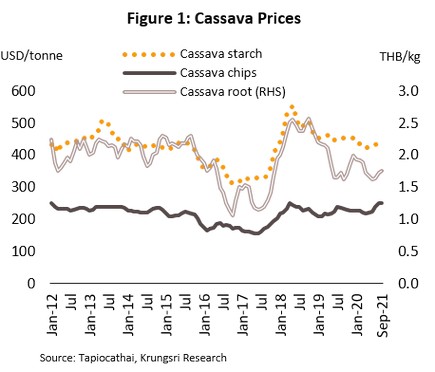
Outlook for 2022-2024
- Outputs of fresh cassava are predicted to expand by 2.0-3.0% annually thanks to an expansion in the area under cultivation, sufficient water supplies, government support for farmers, and the price incentive provided to growers by recovery in the world economy and the government support for exports. Distribution to the domestic market would grow by 2.5-3.5% p.a., on: (i) anticipated recovery in the food industry following the easing of the COVID-19 crisis; (ii) rising demand for cassava for use in ethanol production; and (iii) greater concern over public hygiene that will support stronger demand for cassava chip for use in alcohol production. Exports of cassava products would expand by 5.0-6.0% annually.
- Cassava chip: Exports will rise by 6.0-7.0% per year to a total of 6.1-6.7m tonnes. Demand from the main export market of China will be strong for use in the production of disinfecting alcohol, ethanol (for use in construction and as a power source), and in animal feed.
- Cassava pellets: Exports will tend to remain low at around 10-15 thousand tonnes, with demand mostly for use as a biofuel and as an animal feed.
- Native starch: Exports will edge up by 2.0-3.0% annually to 3.5-3.7m tonnes. Demand will strengthen from China’s food processing, chemicals and beverage production.
- Modified starch: Exports are forecast to strengthen to 1.2-1.3m tonnes per year (up 1.5-2.5%) on rising demand from China and Japan, in particular from players in food, cosmetics and medicines industries.
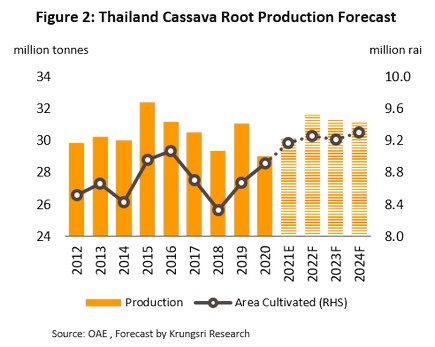
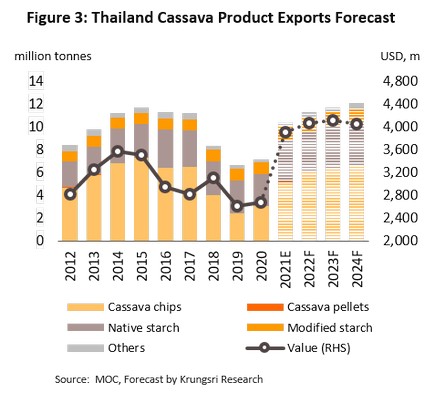
Sugar
Situation in 2021
- In the 2020-2021 growing season, outputs of sugarcane for pressing dropped 11.0%, reducing sugar output by 8.5% YoY to 7.6m tonnes. This was a result of (i) prices for cane that were lower than production costs, and (ii) the drought that ran from 2019 to 2020. However, pressing outputs for the 2021-2022 season are expected to be up 28.6% to 85.8m tonnes on (i) better weather and access to irrigation water, and (ii) the stimulus effects of setting the minimum guaranteed price for 2021-2022 and 2022-2023 at THB 1,000/tonne (not including adjustments based on sugar content and other factors).
- Over 10M21, exports of sugar and molasses crashed 44.5% YoY to 3.1m tonnes, split between 1.5m tonnes of raw sugar (-52.2% YoY), 1.6m tonnes of granulated sugar (-26.7% YoY) and 0.07m tonnes of molasses (-81.5% YoY). These declines were driven by supply shortages, which then impaired the ability of producers to supply export markets. However, demand remained strong, especially from food processors, producers of beverages, and manufacturers of ethanol and alcohol, and as such, export prices for sugar and molasses jumped 34.4% YoY. This then held back the fall in the value of exports, which slipped 25.4% YoY to USD 1.29bn.
- 2021 exports of sugar and molasses combined are expected to shrink by between -40.0% and -45.0% with regard to volume and by between -20.0% and -25.0% with regard to value. This will follow declines in 2020 of 44.2% and 41.5%, respectively. However, compared to a decline of 4.8% last year, domestic demand is forecast to rise by 1.0-5.0% to 2.3-2.5m tonnes, helped by growth in demand from food processors, brewers and distillers, and producers of ethanol and disinfecting alcohol.
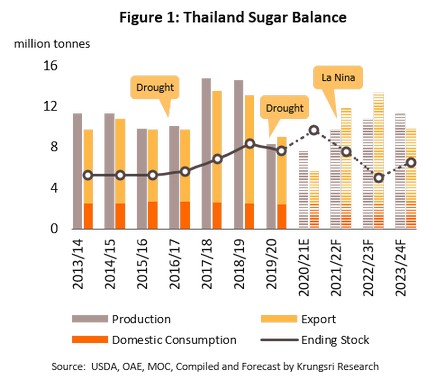
Outlook for 2022-2024
- Output of sugar will tend to rise on the upcoming La Nina which causes water supply to increase and government support for sugarcane growers and sugar producers, including the 70:30 profit split, financial aid for purchases of inputs, and the minimum price guarantees for sugarcane. In addition, the industry will benefit from the minimum price guarantees given by the Thai Sugar Millers Association. Average sugarcane outputs bounce back to around 86-99m tonnes/year, yielding 9.5-11.5m tonnes of sugar annually (this would represent average growth of 10.0-15.0% per year).
- Exports of sugar and molasses should bounce back to around 7-11m tonnes/year (up 25.0-30.0% annually) on: (i) the return of sugar output to its level prior to the 2019-2020 drought; and (ii) recovery in the world economy following the easing of the COVID-19 crisis. Domestic demand is forecast to increase by 2.0-3.0% per year to 2.5-2.7m tonnes/year. The market will be helped by: (i) gradual growth in economic activity, especially for players in the food, beverage, ethanol and disinfectant alcohol industries; and (ii) the setting of a higher minimum ethanol content for the standard gasohol mix.
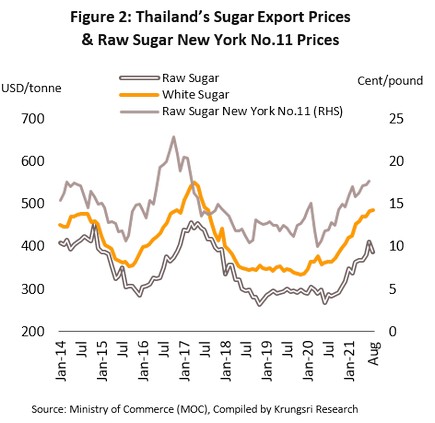

Oil Palm
Situation in 2021
- Over 9M21, quantities of palm fruits used to produce crude palm oil (CPO) totaled 13.1m tonnes, up 2.4% YoY on (i) stronger total demand that lifted prices of palm fruits to THB 6.1/kilo (+52.8% YoY) that encourage farmers to harvest, and (ii) favorable rainfall and weather for cultivation. Palm trees which are properly nourished and harvested with standard guideline could produce high percentage of palm oil to 17.8% from 17.7%. Total output of CPO came to 2.3m tonnes (+3.6% YoY). Unfortunately, domestic demand for use CPO dropped 6.1% YoY to 1.8m tonnes on the COVID-19 pandemic and the combined effects of the lockdown measures and WFH policy, which precipitated a 15.1% YoY slump in sales of transport biodiesel (to 0.86m tonnes). However, exports of palm oil products surged 151.4% YoY to 0.61m tonnes, generating receipts of USD 699.8m (+316.7% YoY) due to government efforts to reduce a supply glut by stimulating exports and stronger global demand, which fed into a 206.0% YoY jump in sales of CPO, bringing this up to 0.55m tonnes. The major export markets were India (up 190.2% YoY to 0.39m tonnes) and Malaysia (up 277.9% YoY to 0.12m tonnes).
- In the remainder of 2021, output will continue to benefit from high prices while demand is driven by export markets with government support. For 2021 overall, output of fresh oil palm is thus forecast to increase 9.5% to 16.4m tonnes. But weaker domestic demand for crude palm oil (esp. those related to energy) will bring demand down by 2.0% to 4.0%. Given the jump in export demand from India and Malaysia seen earlier in the year, 2021 exports are expected to rise 85.0-90.0%, pushing up prices and cutting year-end domestic stocks of CPO to 0.16-0.18m tonnes, below the buffer stock of 0.20-0.25m tonnes. Prices for fresh palm and CPO will rise by respectively 47.3% (to THB 6.7/ kg.) and 32.0% (to THB 37.1/kg.). Prices for exports of palm oil products are also expected to climb 60.0-65.0%.
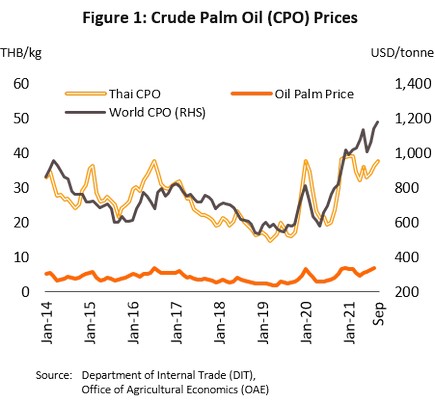

Outlook for 2022-2024
- Fresh palm output is forecast to rise by 4.0-5.0% per year thanks to (i) the earlier expansion in plantations, with these trees now at an age when yields are high, and (ii) the impact of government income guarantees and potential high prices. In addition, domestic demand for CPO is likely to rise by 4.0-5.0% annually on growth in downstream industries (esp. transportation) and the switch to B10 as the standard diesel mix (i.e., this will now be 10% biodiesel). Exports should return to annual growth at the more normal level of 2.5-3.5%, helped by demand from the major markets of India and Malaysia and by government efforts to rebalance the market for palm oil.
- Income for growers is unlikely to rise, and may become more uncertain. The price of fresh palm fruits is expected to slide on higher quantities in Thai and overseas markets (yields per rai in both Malaysia and Indonesia are trending upwards), and in the process, prices may also show greater variability.
- CPO refineries will see turnover rise at levels similar to those of the recent past. Although demand will be boosted by government support for the industry (e.g., for power generation, promoting greater consumption of biodiesel, and supporting exports), production capacity across the industry exceeds the volume of fresh palm. This excess capacity and stiffer competition for access to raw materials would raise CPO production costs.
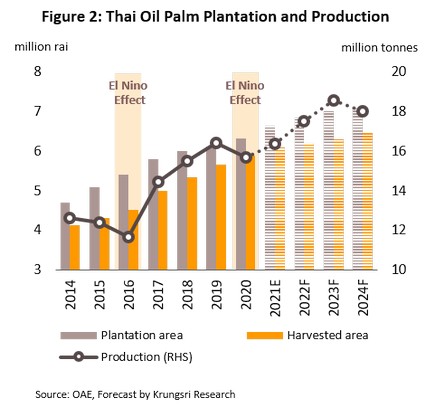
Chilled, Frozen and Processed Chicken
Situation in 2021
- Over 9M21, output of chilled, frozen and processed chicken slipped 2.5% to 1.9m tonnes due to outbreaks of COVID-19 in processing plants that then forced their temporary closure. Domestic demand shrank 1.4% YoY on weakening consumer purchasing power and the effects of the lockdown on purchases from businesses such as restaurants. However, exports rose 5.2% YoY to 0.7m tonnes, helped by demand provided by the Tokyo Olympics and the rush to reach EU import quotas. Unfortunately, export prices slipped 8.4% YoY and this then cut the value of exports to USD 2.4bn (-3.6% YoY).
- The impact of COVID-19 will continue to be felt across the industry through the remainder of the year. For all of 2021, output is expected to slip by 4.0-5.0% to 2.38-2.40m tonnes, while domestic demand will be reduced by 1.0-2.0%. Exports are forecast to rise 7.0-8.0% to 0.9-1.0m tonnes. COVID-19 has caused production in some exporting countries to slow or to halt. Although Thai producers have also been affected by COVID outbreaks, Thai chicken production processes are held in high regard internationally, and so overseas buyers have turned to Thai producers, particularly those from Malaysia, the Netherlands, South Korea, the CLMV nations, and countries in Africa and the Middle East. However, farm prices have fallen somewhat, dropping to an average of THB 33.0-34.0/kg from THB 35.5/kg in 2020. The temporary closure of processing facilities forced farmers to hold on to their flocks, which then grew beyond the standard export size[1], while there was also insufficient cold storage space for chicken meat that had been processed and so operators were forced to offload stock at discounted prices. At the same time, costs have risen for the prevention and treatment of outbreaks of illness in flocks and workers, feed (especially for corn), and transport and shipping. As such, operators’ margins have narrowed.

Outlook for 2022-2024
- Both supply and demand will strengthen, helped by the impact of economic recovery on both domestic and export markets. Output is thus forecast to rise by 4.0-6.0% annually to 2.58-2.79m tonnes, while domestic demand will increase by 7.0-8.0% per year, lifted by economic recovery especially the rebound in the tourism, hotel and restaurant industries. Exports are also expected to grow at the average annual rate of 5.0-6.0% on stronger demand in major export markets, including Japan, the UK, and China.
- Operators will have to contend with the risk of rising costs due to more expensive animal feed and the imposition of non-tariff barriers to trade, in particular the greater use of those related to animal welfare and environmental protection (e.g., checking that animal feed is not sourced from deforested land, and that animals are raised in environmentally friendly conditions). Players will therefore need to pay greater attention to these issues and to raise production standards to meet these requirements, and increase their competitiveness.
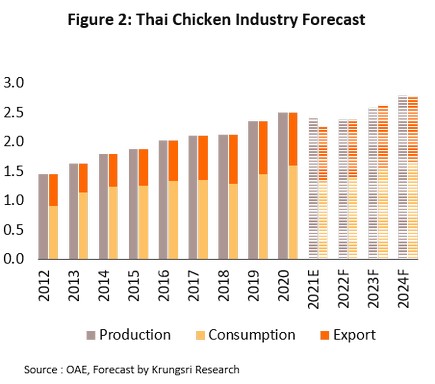
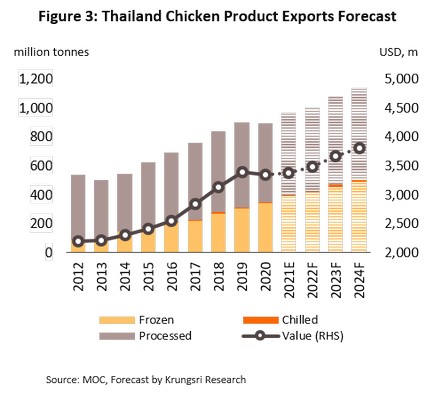
Canned Fish
Situation in 2021
- The canned fish industry suffered its sharpest contraction in 4 years over 9M21 owing to (i) labor shortages caused by the continuing spread of COVID-19; (ii) insufficient sheet steel supply which caused a 53.6% YoY jump in prices and raise production costs; and (iii) transportation problems caused by a shortage of container space and high freight charges that weighed on imports of fish for canning and on exports of finished goods. Output of canned fish dropped 14.1% YoY, with declines seen for both canned tuna (-15.8% YoY) and sardines (-5.8% YoY). This pulled down sales to the domestic market (17.4% of total output) by 8.4% YoY, while exports (82.6% of total output) fell by 23.4% YoY to 0.37m tonnes. In addition, higher import duties and falling demand in major export markets are also weighing on growth in the industry. Thus, exports declined to almost all major overseas markets, including the US (-40.8% YoY), Libya (-64.5% YoY), Japan (-19.6% YoY), Australia (-18.0% YoY), and Saudi Arabia (-36.6% YoY). Export prices also weakened in 9M21, dropping 0.7% YoY for canned tuna and 3.8% YoY for canned sardines to give an overall decline of 2.1% YoY. This was partly caused by stronger competition from players from countries that have lower production costs, including the Philippines, Indonesia, Vietnam and the ACP countries (Africa, Caribbean and the Pacific). As a consequence, the export
s value of canned fish slumped 25.1% YoY to USD 1.40bn.
- In Q4, although the COVID-19 pandemic is beginning to abate, the industry is still saddled with falling orders and high production costs, especially for oil and steel. For 2021, having grown 10.7% in 2020, output of canned fish is forecast to decline by 10.0% to 14.0%. Exports are predicted to drop by 20.0% to 22.0% in volume, largely because of a softening in demand for canned tuna and fell by 22.0% to 24.0% in value.

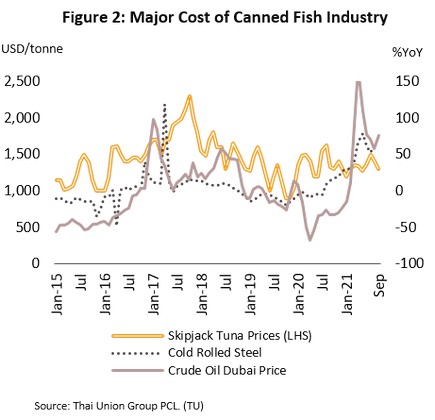
Outlook for 2022-2024
- The canned fish industry is likely to rebound in the coming period, and output is forecast to strengthen by 5.0%-6.0% per annum on: (i) a recovery in world trade and the global economy, which will spur higher demand in export markets; (ii) Thai players’ advantages with regard to health and hygiene (these are mostly medium to large-scale operations); and (iii) ongoing development of new higher value-added products by Thai seafood companies. As such, the volume and value of exports are predicted to increase by an annual average of respectively 4.0%-7.0% and 3.5%-6.5%.
- Challenges facing the industry will include (i) more unpredictable weather, which may affect the catch; ii) a shortage of inputs; (iii) rising production costs (e.g., for fish, steel and energy); (iv) a shortage of unskilled labor, and increasing barriers to trade, especially of non-tariff barriers (e.g., policies that aim at reducing or preventing unsustainable fishing practices or the use of illegal labor); and v) the industry will rising health concerns and a greater desire to eat fresh food in place of canned or processed foods. These factors will then drag on profits, especially for SMEs.
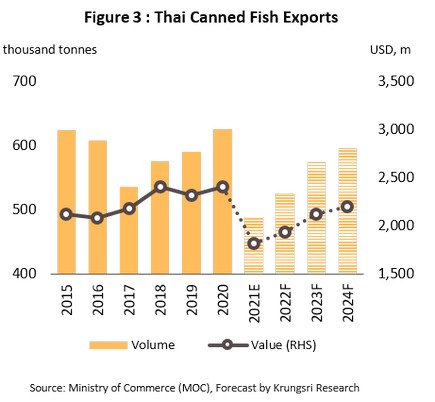
ENERGY & UTILITIES
Power Generation
Situation in 2021
- Demand for electricity rose 1.0% YoY in 9M21 on a 5.5% YoY increase in consumption by industry (responsible for 45.0% of total electricity demand). Individual sectors that reported the greatest rise in electricity usage were, in order, auto assembly, steel and basic metals, rubber and rubber products, electronics, chemicals, and plastics. Household electricity consumption also edged up 0.7% YoY in the period, but consumption by the business sector dropped 7.0% YoY, with the biggest declines seen in areas connected to tourism, including hotels, restaurants, financial institutions, department stores, and apartments and guesthouses. Peak demand was also up 5.2% to a maximum in April of 30,135.3 MW.
- Electricity generation increased 0.7% YoY in 9M21. Generation by EGAT (30.8% of the total) fell 5.5% YoY, while from the private sector, supply from IPPs (22.2% of the total) fell 0.2% YoY and supply from SPPs (25.3% of the total) fell 0.6% YoY but up 3.5% YoY from VSPPs (5.7% of the total). The remainder came from imports from neighboring countries (the remaining 16.0%), which rose 18.4% YoY.
- In 1H21, installed renewables capacity that was contracted to sell into the grid rose 3.1% from its level at the end of 2020 to reach 9,368.4 MW[1]. Biomass, wind and biogas capacity rose by respectively 7.0%, 1.6% and 1.5% in the period. But the quantity of electricity actually supplied to the grid was only 46% of that specified in the AEDP 2018 plan, which sets a goal of 26,491 MW[1] by 2037. The best performing segment was biomass electricity production, which was 65% of the target, followed by micro-hydro, wind, community waste-to-energy, biogas and solar.
- Electricity consumption will continue to rise in the rest of 2021, now that controls on economic activities have been relaxed and the country has reopened to international tourists. Compared to the fall of 3.1% seen in 2020, average demand for electricity in 2021 is thus expected to be up 1.5%.
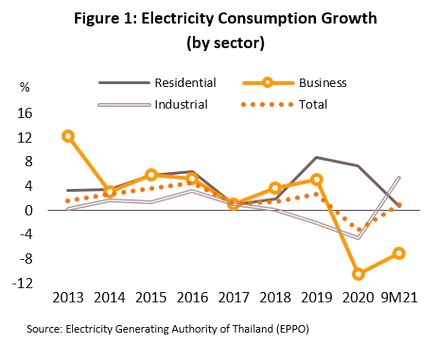
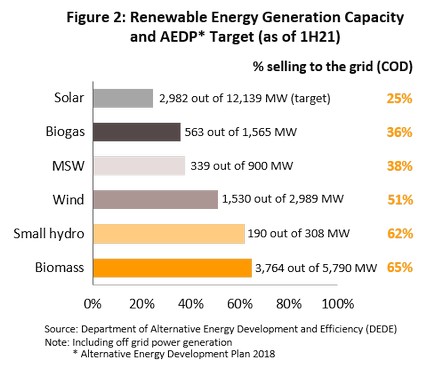
2022-2024 Outlook
- The power generation sector will see continuing growth in the coming period, with demand expected to rise by 3.6% annually over the next 3 years on gradual economic recovery, and the PDP, which is encouraging investment in each of the 3 main types of power plants, and with this, installed capacity will expand.
- IPPs: Competitive bidding is expected to be held in a number of locations, with the authorities in particular planning to hold auctions for 700 MW of new supply per year in the west of the country over 2021 and 2022. This will replace 8,300 MW of natural gas-powered plants that will see their supply contracts expire over 2025-2027.
- SPPs: Investment in new power plants and additional generating capacity should be ongoing, especially in natural gas cogeneration plants which contracts will expire in 2019-2025, and SPP hybrid renewables, which benefit from input costs that are significantly below retail electricity prices[2]. Investment should also increase in the EEC to meet stronger future demand in the area.
- VSPPs: Investment will accelerate in 2022, and because the government has set targets for increased purchases over 2022-2024, this will particularly affect rooftop solar installations, biomass, biogas, and waste-to-energy schemes. These segments also benefit from producers’ cost competitiveness and access to raw materials.

Oil Refineries
Situation in 2021
- Global prices for crude oil rose through 9M21 with the economic rebound and ensuing recovery in consumption. The latter took demand to 96.6m bbl/day, while supply lagged at 94.7m bbl/day, and the gap between the two served to push up prices by 58.1% YoY to an average of USD 65.8/bbl. At the same time, average gross refinery margins (GRMs) widened to USD 0.9/bbl, having averaged just USD 0.3 through 9M20.
- Thai refiners had to make do with depressed turnover that suffered under the twin impacts of tight global GRMs and the severe outbreak of COVID-19 from April to September that then cut 8.3% YoY from 9M21 demand. Demand for diesel[1] fuel and gasoline[2] (product) thus fell by 6.0% YoY and 8.7% YoY in the period, while sales of jet fuel crashed 46.0% YoY. However, the cost of crude oil that rised in line with global market lifted average pump prices for diesel fuel and gasoline to THB 34.9 and THB 27.3, respectively, from THB 29.3 and THB 20.2 per liter average in 9M20. Capacity utilization stood at 77%.
- In Q4, refiners will see an improvement in the business environment as economic activity rebounds and tourism begins to recover. For all of 2021, the situation will be as follows.
- Dubai Crude oil price should rise to an average of USD 69.5/bbl (against USD 42.2 in 2020), while the Singapore GRM will widen to USD 2.0/bbl (compared to USD 0.3 last year).
- Domestic demand for refined products will be down by between 5.0% and 6.0%, having already fallen 12.1% in 2020, while prices for gasoline and diesel fuel will rise from 2020’s average of THB 29.3 and THB 22.4 per liter to THB 35.5 and THB 27.9 per liter. However, capacity utilization is expected to slip to 77% from last year’s 81% because some refineries have remained down for repairs for longer than expected.
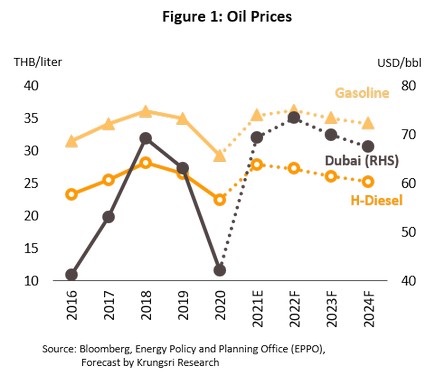
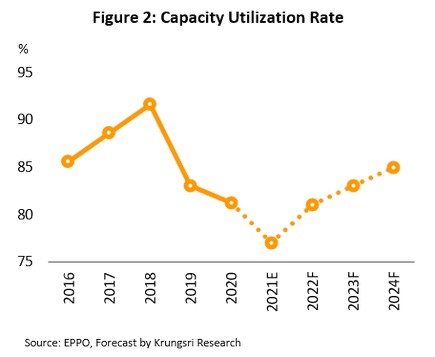
2022-2024 Outlook
- Over the next 3 years, the average price for Dubai crude oil will remain close to its 2021 level, with high capacity limiting the room within which prices may rise. Dubai crude oil is thus forecast to average USD 73.5/bbl in 2022 before sliding back to USD 70.0 and USD 67.5/bbl in 2023 and 2024. Recovering global demand for refined products (with the exception of jet fuel, demand for which is still restricted by limitations on air travel) will then help to increase the Singapore GRM to an average of USD 3.0-4.0/bbl over 2022-2024.
- Domestic prices for refined products will tend to rise with economic recovery. Prices for gasoline are predicted to climb to THB 36.3/liter in 2022, before softening to averages of THB 35.1 and THB 34.3 per liter in 2023 and 2024. Over the same three years, prices for diesel are forecast to average THB 27.3, THB 26.1 and THB 25.3 per liter.
- Operators will benefit from rising turnover and stronger profits as domestic demand recovers and the GRM widens. The expected 3.0-4.0% annual increase in the size of the national vehicle fleet will help to underpin rising consumption of refined products, and thus demand is likely to expand by 2.5-3.5% per year. In addition, because no new refining capacity is planned for the next 3 years, capacity utilization should rise to 80-85%.
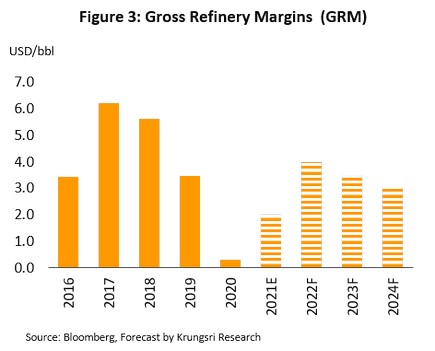
Ethanol
Situation in 2021
- In 9M21, consumption dropped 9.9% YoY to an average of 3.60m liters/day caused by reduction of gasohol demand (-9.0% YoY). Demand was seriously affected by the outbreak of COVID-19, and restrictions on inter-province travel. For the remainder of 2021, the lifting of these controls and the reopening of the country in November should boost traveling and demand for ethanol. Across the year, demand is expected to average 3.79m liters/day, down 6.1% from 2020’s average of 4.03m liters/day.
- Ethanol production slipped 7.7% YoY to 3.79m liters/day in 9M21 on a fall in the supply of inputs, in particular of sugarcane, hit by the drought. This caused a 12.7% YoY fall in production of ethanol made from molasses (down to 2.25m liters/day) and a 4.8% YoY drop in production from sugarcane (to 0.19m liters/day). However, thanks to higher quantities and prices that were lower than those for sugarcane, these declines were partly offset by a 1.4% YoY increase in output of ethanol made from cassava, which then rose to 1.36m liters/day. Because demand fell faster than supply, at the end of September, ethanol inventories stood at 101.6m liters (+18.1% YoY), while for all 2021, capacity utilization would fall to 63% from 2020’s 68%.
- Manufacturers producing ethanol from fresh cassava and cassava chip stayed profitable in the period, despite the cost of these rising to respectively THB 2.03/kilogram (+14.8% YoY) and THB 5.97/kilogram (+10.6% YoY), which pushed up production costs to THB 20.77/liter (+8.5% YoY) and THB 23.78/liter (+6.8% YoY). However, with average prices running to THB 9.06/kilogram (+74.8% YoY), operators producing from molasses had to shoulder costs that rose to their highest in a decade. This ramped up production costs to THB 45.30/liter (+55.5% YoY), against an average reference price of THB 25-26/liter, rising from THB 23.21/liter in 2020
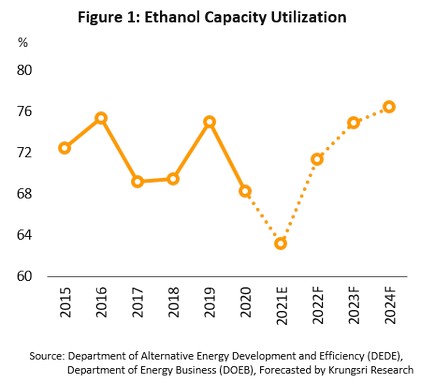

2022-2024 Outlook
- Demand for ethanol is forecast to rise to 4.2-4.6m liters/day (up 5.5% annually), moving in step with greater consumption of gasohol E10 (95) and E20. (It is estimated that sales of these will increase to the point that they represent 25-30% of all sales of gasohol). This outlook is supported by the following:
- The government plans to make E20 the standard gasoline mix in 2023 (during a process of drawing up a new ethanol reference price). This will stimulate greater consumption of biofuels and replace sales of E10, which the government plans to withdraw from distribution in 2022, boosting demand for ethanol to 6-7m liters/day from the 2021 level of 4-5 liters/day.
- Demand will strengthen steadily with the completion of the vaccine program and the reopening of the country to foreign arrivals, which will then help the economy return to growth.
- The number of vehicles on Thai roads capable of running on gasohol is increasing by 1.5-2.5% per year, and by the end of the period, the total is expected to reach 30-32m vehicles, up from 29.8m as of October 2021. Particularly important will be the annual addition of 0.8-0.9 million new models that are capable of running on E20.
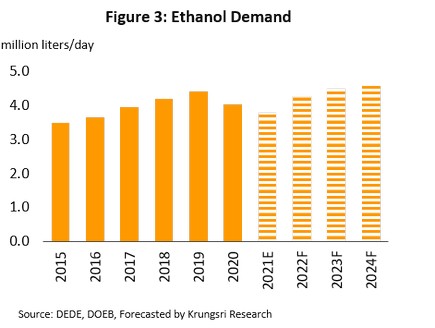
Biodiesel
Situation in 2021
- Production of biodiesel dropped 8.0% YoY over 9M21, slipping to 4.61m liters/day as the effects of the COVID-19 outbreak and the subsequent decline in travel and corresponding increase in working from home cut into consumption of B100 for mixing with mineral diesel. Demand thus declined 9.1% YoY to an average of 4.64m liters/day. In Q4, the slowing of the pandemic and the easing of the lockdown will translate into an improving outlook for the industry, and so for 2021 overall, average biodiesel output and demand will come to respectively 4.74m liters/day (-6.0%) and 4.76m liters/day, 0.35m liters/day below its 2020 level. However, new facilities have come online, lifting production capacity by 13.7% to 9.4m liters/day, and so for 2021, capacity utilization will drop to 50.4%, down from 60.9% in 2020.
- Over 9M21, the biodiesel reference price (used in sales by producers to distributors) increased by 31.6% YoY to THB 39.1/liters or THB 45.2/kg. This was due to: (i) labor shortages in Malaysia and Indonesia (major exporters) that then caused a drop in outputs of palm oil; (ii) increased exports of crude palm oil (CPO) from Thailand; and (iii) a decline in domestic stocks of CPO to the buffer stock level of 0.20-0.25m liters. As such, prices for CPO and palm stearin jumped by respectively 39.9% and 21.8% YoY, ending at THB 35.8/kg and THB 36.2/kg each. The CPO-biodiesel spread was thus wider in 9M21, increasing to THB 9.4/kg from THB 8.8/kg in 9M20.

2022-2024 Outlook
- Overall, the biodiesel industry will be able to look forward to average annual growth of 4.0%-6.0% annually. Demand would increase to 5.3-5.5m liters/day, boosted by the following factors.
- Demand for the use of diesel-powered vehicles in the transportation sector will rise on: (i) an economic recovery; (ii) expansion in e-commerce sales, which will increase use of commercial vehicles (especially pickups); (iii) greater economic integration across the ASEAN region that will drive greater use of commercial vehicles; and (iv) an average increase of 3.0%-4.0% in the number of diesel-powered vehicles on Thai roads.
- Government efforts to restore balance to the palm oil market will include encouraging greater exports of CPO (to reduce the current supply glut), increasing the proportion of B100 in the standard diesel mix, better management and control of stocks, and measures to encourage higher demand for biodiesel through price support managed via the Oil Fuel Fund.
- Major auto manufacturers are developing engines that can run on diesel containing a higher proportion of biodiesel, and these will be installed in large trucks, pickups, SUVs and regular sedans.
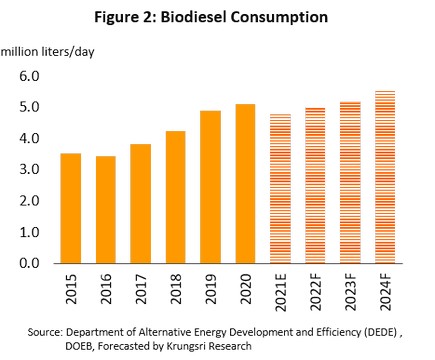
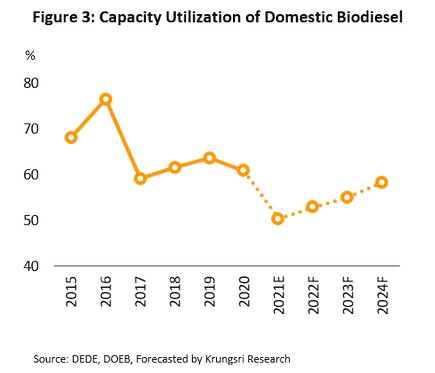
PETROCHEMICALS
Petrochemicals
Situation in 2021
- Demand for petrochemicals strengthened through 9M21 in step with recovery in manufacturing at home and abroad. At the same time, the rising cost of crude oil pushed up prices for all the main petrochemical product groups, including polyethylene (PE), polypropylene (PP), PET and ABS, which were up respectively 28.6%, 30.4%, 30.5% and 68.2% YoY. Demand for petrochemical products from downstream industries is forecast to increase steadily through the rest of the year, and as such, 2021 growth in demand from domestic and export markets is expected to hit 9.0-9.5% and 5.0%, respectively, having each slipped by 4.6% and 1.5% a year earlier.
- Naphtha prices averaged USD 630.3/tonne, up 67.6% YoY on rising crude oil prices. For all of 2021, the cost is expected to average USD 640/tonne.
- Upstream petrochemicals: The ethylene spread averaged USD 373.1/tonne in 9M21, up from USD 278.1 in 9M20, while for benzene, the spread averaged USD 301.6, compared to USD 111.6 a year earlier. For 2021 overall, spreads are forecast to average around USD 340 and USD 278/tonne, respectively.
- Downstream petrochemicals: Polyethylene (PE) spread narrowed to USD 121.2/tonne from USD 152.1 in 9M20 as cost increases outpaced price rises. But for polypropylene (PP), spreads widened from USD 149.4/tonne to an average of USD 282.8. For 2021, spreads for these two products are expected to average USD 120 and USD 282 per tonne, respectively.
- Players in the petrochemicals industry will see improving returns through 2021 thanks to a combination of rising prices and stronger demand from downstream consumers, though the escalating cost of inputs may put some pressure on profits.
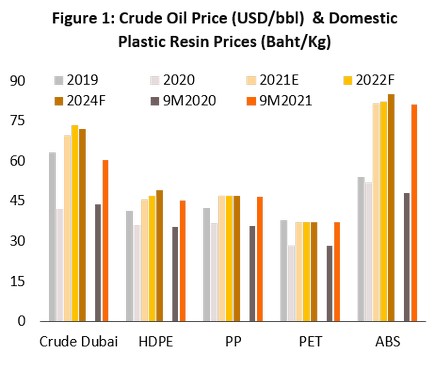
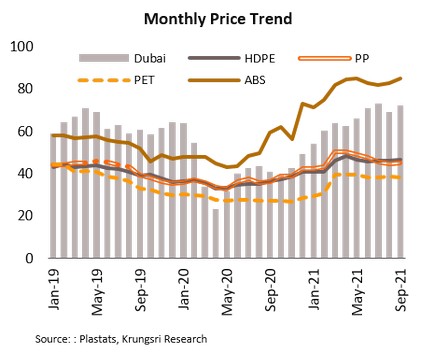
2021-2023 Outlook
- Demand for petrochemicals is expected to rise from downstream industries (e.g., packaging, construction, auto assembly, and medical devices) combine with continuing worries over public health that will boost demand for single-use plastic goods (i.e., those made from PE, PP, and PET). However, global crude prices are expected to average around USD 70/bbl over 2022-2024, and this will tend to squeeze spreads. Overall, volume of demand for petrochemical products for domestic use and export is expected to grow over the next 3 years at averages annual rate of respectively 3.5-4.0% and 4.5-5.0%.
- Petrochemical players will tend to shift production lines to a stronger emphasis on high-value specialty products, such as ABS, as they look to meet demand for plastics for use in, for example, the production of EV auto parts, batteries and medical equipment. To increase market opportunities and to move beyond depending entirely on traditional products, some players will also increase investment in the production of biodegradable and recycled plastics.
- Competition will tend to increase due to new production capacity coming online in Asia. This will include new petrochemicals facilities in China (part of an official policy to decrease the country’s dependency on imports) and Malaysia (i.e., the PrefChem project, a joint-venture between Petronas and Saudi Aramco).

CHEMICAL
Pharmaceuticals
Situation in 2021
- The Thai pharmaceuticals industry is predominately focused on the production of downstream finished goods. Drugs produced in-country are generally generics, with imported active ingredients mixed and processed into finished goods that are largely bound for the domestic market (around 90% of total outputs is consumed within the country). In 2021, the value of pharmaceuticals distributed domestically is forecast to reach THB 193bn (up 2.5%), though this will be a slowdown from 2020’s growth of 2.8%; in the year, the COVID-19 outbreak caused a decline in uptake of hospital services for non-serious conditions, while sales through pharmacies slowed with weakening consumer spending power. The general situation for 9M21 is given below.
- Domestic sales[1] of pharmaceuticals mostly declined, with sales of tablets (48.8% of the market) down 11.0% YoY and solutions (20.6% of the market) slipping 1.0% YoY and medical cream (7.7%) declining 4.2% YoY, but distribution of capsules and injectables (9.5% and 8.6% of the market each) was up 0.1% and 2.9%, respectively.
- Exports slipped 5.4% YoY to THB 9.3bn. The value of pharmaceuticals distributed to the CLMV zone (58.3% of all exports, by value) shrank 7.3% YoY, those to Japan (6.6% of exports) fell 5.8%, and those to the Philippines, Hong Kong, Malaysia, and Singapore (combined, 17.9% of the total) dropped 12.9% YoY. At the same time, imports climbed 7.3% YoY to THB 46bn, rising 0.2% YoY from Germany (13.1% of imports of pharmaceuticals, by value), 31.7% YoY from Japan (8.0% of imports), and 6.8% YoY from the US (7.8% of imports), mostly due to higher prices. Imports from India and China (respectively 12.8% and 3.2% of imports of pharmaceuticals) jumped 59.1% and 22.3% YoY on a combination of stronger demand for precursor chemicals and price rises.

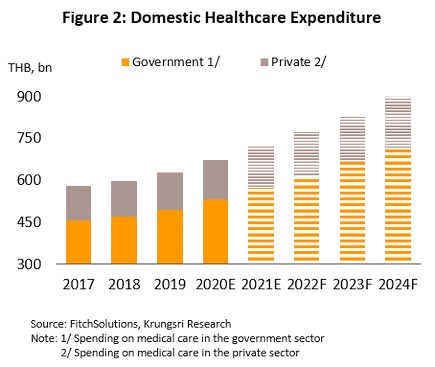
2022-2024 Outlook
- The value of pharmaceuticals distributed to the domestic market is expected to increase by an average of 3.5-4.5% annually. Demand growth will be driven by: (i) increasing ill-health among the population as it ages, with rates rising especially for chronic NCDs, which typically require treatment with expensive imported medicines; (ii) the accessibility of health insurance across the population, which will stoke greater demand for generics; and (iii) rising concerns with health and wellbeing that have been given a strong boost by the COVID-19 pandemic. Manufacturers will thus tend to increase investments to meet rising demand.
- Competition is also likely to strengthen on: (i) imports of low-cost Indian and Chinese medicines; (ii) the entry into the domestic market of new overseas players that will produce generics in Thailand for sale into domestic and export markets; (iii) the expansion into pharmaceuticals of players active in other businesses; and (iv) rising costs for domestic producers, which will need to meet the overheads involved in upgrading facilities to meet the GMP-PIC/S[2] standards, while also contending with higher prices for imports of medicines and active ingredients (these are rising on stronger demand for precursors).
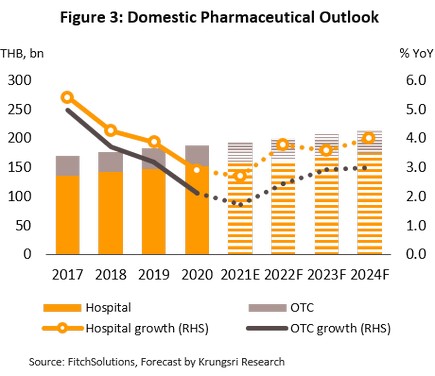
Chemical Fertilizers
Situation in 2021
- Demand for fertilizer for use with the major cash crops (rubber, oil palm, and out-of-season rice, for which fertilizer is applied heavily) rose through the year, helped by improving farmers’ purchasing power on better rainfall that then encouraged farmers to extend the area under cultivation and higher prices for agricultural goods. For all of 2021, demand is thus expected to rise 2.0% to 5.4m tonnes.
- In 9M21, combined imports of straight fertilizer (65.3% of all imports of fertilizer) and of mixed fertilizer (34.7% of imports) rose 8.2% YoY to 4.7m tonnes valued at THB 57bn (+46.6% YoY). For the year overall, imports are forecast to be up 6.0% to 5.6m tonnes.
- Exports of fertilizer (5% of domestic output) jumped 28.8% YoY in 9M21 to a total of 0.57m tonnes, valued at THB 6.7bn (+55.0% YoY). Exports to the main market of the CLMV nations, which absorbs 80% of fertilizer exports, climbed 19.6% YoY on stronger demand from Cambodia (35.1% of exports) and Myanmar. For 2021 in total, exports are thus forecast to be up 24.0% to a 3-year high of 0.72m tonnes.
- Domestic retail prices[1] for fertilizer generally slipped over 9M21 in response to government requests for price reduction to assist farmers (with the exception of urea and ammonia sulfate, for which prices rose by respectively 4.6% and 3.3% YoY as cost of imported inputs continued to rise) This will therefore weigh on income for manufacturers and distributors that import straight and mixed fertilizer.
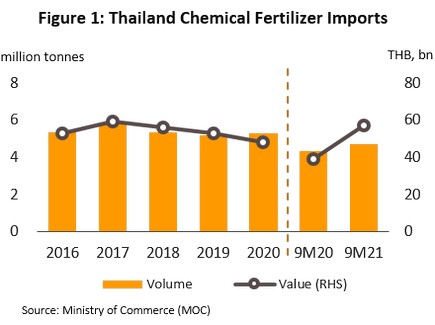
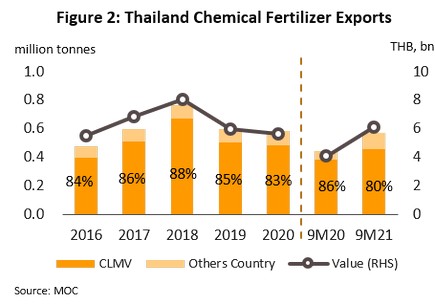
2022-2024 Outlook
- Demand is predicted to strengthen by 2.5% annually over the next 3 years, consumption thus rising to 5.6-5.8m tonnes for use with the major crops of rice, corn (for animal feed), oil palm, sugarcane, rubber and cassava. Of these, rice (expected to rise by 1.5-2.5% annually), corn and cassava (expected to rise by 2.0-3.0% annually) are particularly important, with a combined share of around 60% of all fertilizer use.
- Manufacturers will try to expand their market access and range of distribution channels, for example by adding value through the development of new products (e.g., by producing bespoke fertilizer mixes) and by increasing exports to neighboring countries. However, growing concern with personal health is spurring greater interest in organic farming and the use of bio-fertilizers, and this may affect future sales of chemical fertilizers.
AUTOMOTIVE & PARTS
Automobiles
Situation in 2021
- Outputs jumped 31.9% YoY over 8M21 to a total of 1.07m units, largely thanks to the decision by Japanese manufacturers to export a greater number of vehicles from Thailand. But despite this, production was still hampered by the COVID-19 pandemic and subsequent shortages of chips and labor. Domestic sales were up just 2.4% YoY in the period (to 0.47m vehicles), compared to a sharp drop in 8M20, the pandemic continued to affect the economy and to undermine consumer spending power, while lenders also moved to tighten the release of new loans. However, exports performed well in the period, jumping 31.9% YoY by volume to 0.60m units and 46.9% YoY by value to USD 12.3bn as Japanese companies stepped up their exports from Thailand and trading partners economies improved. Thus, sales were up 229.5% YoY to Malaysia, 107.1% YoY to New Zealand, 69.7% YoY to Japan, 83.8% YoY in Vietnam, and 58.2% YoY to Australia (these countries accounted for 50.7% of all exports by value).
- Through the remainder of 2021, although labor shortages have recovered, intermittent problems securing chips may continue to interrupt production. The domestic sales is likely to be affected by weak consumer spending power and so these may fall, but export growth will remain strong. For 2021 overall, auto output should be up 15.0-17.0% to 1.64-1.67m vehicles, with domestic sales down by 2.0-4.0% (to 0.76-0.78m vehicles) and exports up 24.0-26.0% to 0.91-0.93m units.

2022-2024 Outlook
- Over the next 3 years, outputs should rise by 4.0-6.0% annually, helped by the abating of the COVID-19 pandemic now that vaccination programs have reached a significant fraction of the population, the easing of labor shortages, and, from 2H22, an improvement in semiconductor supply chains..
- The number of autos distributed to the domestic market is forecast to rise 3.0-5.0% in 2022 and then by 4.0-6.0% in 2023 and 2024 on the better economic outlook, which will then translate into higher consumer confidence. Expansion in construction, online retail and logistics will support strong demand for commercial vehicles, while manufacturers will release a steady stream of new models (both EVs and ICE-powered vehicles).
- Exports are predicted to rise 5.0-7.0% in 2022 and then by an average of 4.0-6.0% in each of the following two years. Overseas sales will be boosted by (i) Japanese companies to increase their use of Thailand as a base for producing vehicles for export; (ii) trade partners’ economic recovery; (iii) ASEAN MRAs that recognize individual country’s testing and standards of autos and auto parts, which is then making import procedures much easier to navigate.; and iv) growing exports to the Philippines (with a 7.1% share of export value in 2020, this was Thailand’s 3rd most important export market), helped by the closure of local production lines.
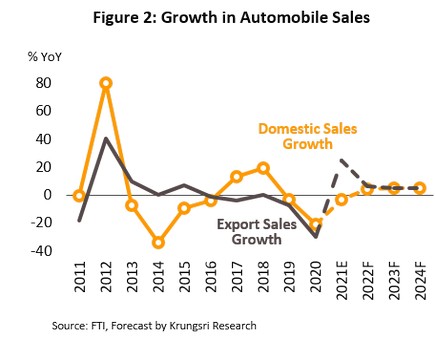
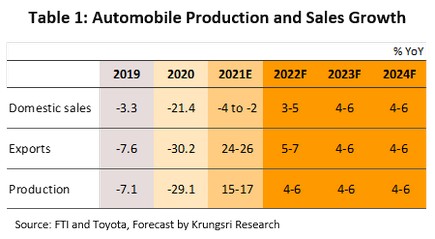
-
Dealerships of New Vehicles
Situation in 2021
- Over 8M21, distributors of new vehicles saw income rise only slightly, moving with the 2.4% YoY increase in sales (up to 0.47m units). Auto outputs were periodically affected by shortages of key parts, and although manufacturers increased their online presence to make it easier for customers to make purchases, this failed to offset the effects of COVID-19 on footfall in auto showrooms. Income from services and the sale of spares and parts is also expected to fall with the decline in the number of vehicles under 5 years old on Thai roads (for 5M21, this was down 1.1% YoY to 4.97m units). In addition, the increase in working from home has reduced auto usage and so some owners have delayed services and repairs.
- Business conditions will remain depressed through the rest of the year, and so for 2021 overall, sales are expected to be down from their 2020 level. Income from sales will move in step with a weaker market and an expected 2.0-4.0% drop in distribution to 0.76-0.78m vehicles, while income from services and sales of parts will fall in step with the estimated 0.7% decline in the number of registered vehicles under 5 years old.
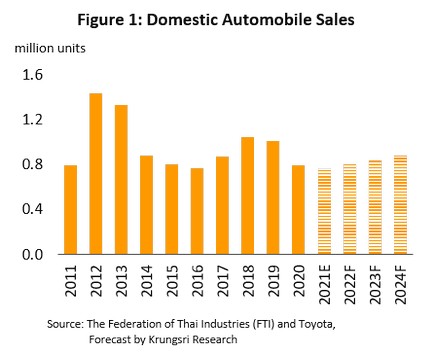
2022-2024 Outlook
- Domestic sales of new cars are expected to rise, by 3.0-5.0% in 2022 and 4.0-6.0% in 2023 and 2024. Supply shortages of important parts are forecast to ease in 2H22. However, income from servicing and the sale of parts will tend to weaken with the decline in the vehicle fleet aged less than 5 years old. Although vehicles will still need to be serviced with age and use, there is a risk that some owners will save on expenses by using the services of general mechanics. Beyond this, distributors of new vehicles will see their profits come under pressure from manufacturers’ policies, e.g., through the additional expenses involved in having to upgrade and modernize showrooms and service centers.
Situation in 2021
- Demand for second-hand vehicles grew solidly in 8M21 on: (i) a shortage of key parts that slowed auto assembly lines, reducing output and encouraging some drivers to buy second-hand vehicles instead; (ii) fears over the spread of COVID-19 that pushed some travelers off public transport and into private vehicles; and (iii) the need to use vehicles to make a living, particularly among workers affected by the temporary closure of businesses. The enforcement of debt moratorium meant that repossessions slowed[1], though these were also affected by restrictions on inter-provincial travel. As a consequence, used car prices index jumped 7.1% YoY in the period.
- Sales will continue to grow in the rest of the year, and overall, these will have performed well in 2021. The market has been lifted by strong demand for vehicles to use to make a living at a time when personal budgets are limited, as well as by second-hand dealers’ policies, which now include checks and guarantees on used vehicles and improved after-sales services.
2022-2024 Outlook
- Sales will tend to rise with the rebound in the economy, while prices may slightly increase, given likely limited supply to the market. The latter will be caused by some owners delaying changing their vehicles while the economic outlook remains uncertain. New players (both foreign companies expanding into Thailand and operations run by major auto manufacturers) are also expected to enter the market, increasing competition and potentially eating into the turnover of current players, most of which are SMEs.
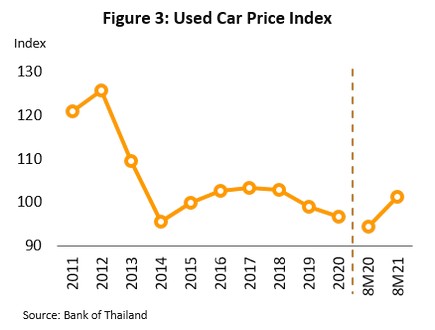
Motorcycles
Situation in 2021
- 8M21 output of motorcycles rose 24.5% YoY to a total of 1.17m vehicles, with domestic distribution (81% of the market by volume) up 7.9% YoY to 1.09m units. The market was helped by stronger demand for use in food and logistics delivery services, which have seen extremely rapid growth through the period of the COVID-19 pandemic. Exports also performed very well and bounced back to growth of 51.5% YoY (or 0.31m vehicles) that then generated income of USD 1.91bn (up 54.4% YoY). Exports benefited from an improving trading partners’ economic recovery once vaccine rollouts had achieved a significant degree of success. Growth was led by the US, where exports rose 142.8% YoY, followed by the EU (+57.2% YoY), China (+46.2% YoY), and Japan (+35.8% YoY), which together account for 82.5% of the value of all exports of motorcycles from Thailand.
In the remainder of 2021, output will tend to drop as sales in the domestic market soften on the low purchasing power of target consumer groups (i.e., farmers whose income has been undercut by flooding and laborers affected by the weak economy) and the high base in the same period last year. Exports will, however, remain vibrant and these will continue to grow with the rebound in trading partners’ economies, especially in the US, the EU, China, and Japan. Having fallen 17.1% in 2020, output of motorcycles for all of 2021 will thus be up 8.0-10.0%, and compared to declines of respectively 11.8% and 20.1% in 2020, domestic and export sales would increase by 1.0-3.0% and 34.0-36.0% each.
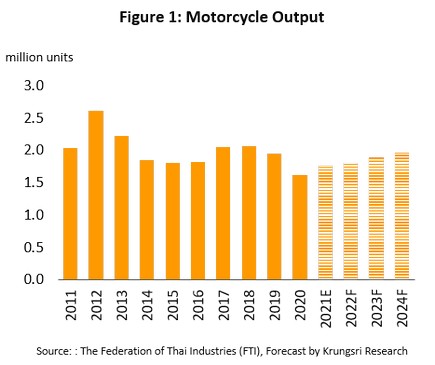
2022-2024 Outlook
- Domestic sales are expected to increase by 2.0-4.0% in 2022 and then at the slightly faster rate of 3.0-5.0% in 2023 and 2024. The relaxation of control measures is allowing economic activity to revive and this will feed into strengthening purchasing power for lower-income earners, who comprise the major domestic target for sellers of motorcycles. Exports will also rise, climbing by 4.0-6.0% in 2022 and then by 3.0-5.0% in each of the next two years, bolstered by trading partners’ economic revival (the US, the EU, China and Japan) and the decision by Ducati to meet stronger export demand by increasing Thailand-based output from 12,000 to 18,000 units per year from 2024 (over 90% of Ducati’s current output from Thai facilities is bound for export markets). Overall, these will support increases in the output of motorcycles of 2.0-4.0% in 2022 and of 3.0-5.0% in 2023 and 2024.
-
Auto parts
Situation in 2021
- Outputs rose steeply in 8M21, and this is reflected in the 39.2% YoY jump in the industry’s manufacturing production index. Demand from the original equipment manufacturer (OEM) market was lifted by the +31.9% YoY and +24.5% YoY increases in the number of autos and motorcycles coming off production lines (total output of these therefore rising to respectively 1.07m and 1.17m vehicles). The replacement equipment manufacturer (REM) market also continued to strengthen with the ever-growing number of vehicles registered in Thailand (Table 1). Likewise, exports performed well, surging 33.1% YoY to a value of USD 14.6bn. Growth was reported in all the main markets, led by the ASEAN zone (+36.9% YoY), followed by the US (+30.4% YoY), Japan (+29.7% YoY) and the EU (+10.6% YoY), which together account for 60.1% of the value of all auto parts exported from Thailand.
- Domestic demand for auto parts will tend to soften in the rest of the year, dropping with slowing output of autos and motorcycles. Nevertheless, having shrunk in 2020, the domestic OEM market will be lifted by growth in the output of autos and motorcycles that is expected to run to respectively 15.0-17.0% and 8.0-10.0% for 2021. The REM market situation would grow on the need for auto repairs in line with age and distance, and extension of the working life of current vehicles because the economy remains depressed and income is uncertain. Exports are expected to increase in step with trade partners’ economic recovery (i.e., in the ASEAN zone, the US, and Japan).

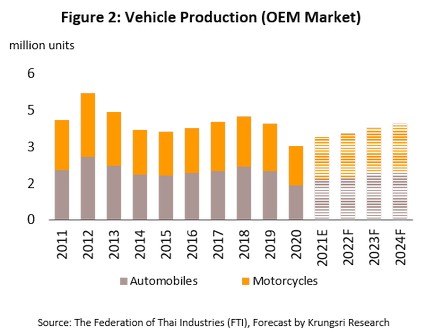
2022-2024 Outlook
- The manufacture and domestic distribution of auto parts are likely to rise steadily on expansion in auto production, and through this, in the OEM market. The REM market is expected to strengthen with increasing number of vehicles registered in Thailand, especially of the vehicle fleet over 5 years old (currently numbering 26m) since demand for REM parts moves with the number of auto repairs and parts replacements that are made, which is itself determined by the vehicle’s age and usage, especially the need for higher value important parts such as engine and transmission, etc. However, growth in the value of exports will tend to slow in the coming period as overall global demand for new vehicles slackens. Thus, Euromonitor estimates that having shrunk 16% in 2021, the global supply of new vehicles will rise by 14% in 2022, 8% in 2023 and just 2% in 2024. This aggressive slowing will be caused by the need to research and develop clean engine technology, which will then push up the cost of new vehicles, and by stronger take-up of ride-sharing services. With regard to the latter, Euromonitor estimates that ‘shared mobility’ services (or ‘mobility as a service’) operations such as Uber, Lyft and Grab will enjoy average growth of 15% over 2022-2024.
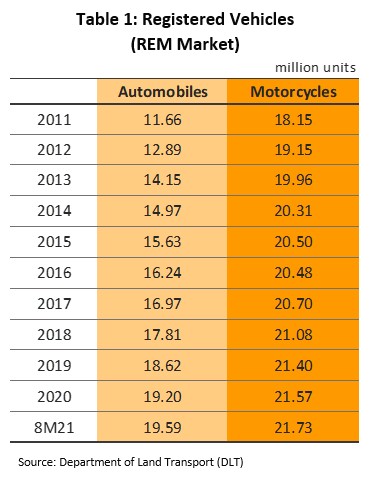
ELECTRONICS & ELECTRICAL APPLIANCES
Electronics
Situation in 2021
- HDD manufacturers performed well through 8M21, with the industry’s manufacturing production index up 5.8% YoY and the export value jumping 17.8% YoY. Export growth of HDDs moved in line with global PC sales growth of 19.0% YoY in 1H21 (most PCs are fitted with HDDs); that was triggered by the huge increase in working from home and studying online amid the COVID-19 pandemic. In addition, many public- and private-sector organizations are increasing their IT spending, especially on data centers, which generally require high-capacity HDDs.
- For the rest of 2021, the manufacture and export of HDDs will continue to rise alongside estimated 2021 growth of 14.2% in the number of PCs distributed globally (IDC, August 2021). Demand for high-capacity HDDs used to store big data will also remain strong, lifted by investment in data centers that will rise 7.4% worldwide in 2021, up from just 2.5% in 2020 (Gartner, Jul 2021). For the year 2021, output of HDDs would therefore move with export value, which is expected to rise by 16.0-17.0% YoY having shrunk 1.8% last year.

2022-2024 Outlook
- Export value of HDDs is expected to grow by 3.0-4.0% annually, supported by (i) demand for high-capacity HDDs for use in cloud computing and data center applications; (ii) growing interest in on-premises data centers1/ and for use in storing blockchain; and (iii) interest in cryptocurrency data and closed-circuit TV footage, and IDC (August 2021). Therefore sales of petabyte-sized HDDs are estimated to rise by an average of 31.0% per year over 2020-2025. However, export growth will be restrained by the increasing trend to replace HDDs with solid state drives (SSDs), especially in notebooks.
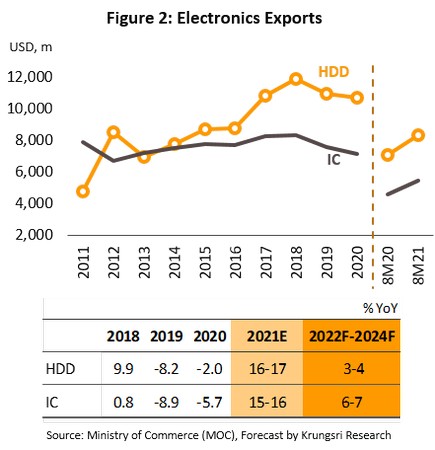
Situation in 2021
- The IC manufacturing production index climbed 15.2% YoY in 8M21, while exports rose 19.0% YoY to USD 5.43bn. Sales moved with the 24.7% YoY expansion in the global distribution of semiconductors in 7M21, itself driven by (i) the surge in sales of electronic devices needed to work from and to study online due to the COVID-19 pandemic; and (ii) rising demand with stronger sales of electric vehicles and of electronic devices connected to the internet of things. The latter has generated shortages of semiconductors (raw materials), and from the start of 2021 onwards, this has periodically dragged on the manufacture and export of ICs.
- Growth in manufacturing output and exports will slow through the rest of 2021 because IC supply chains remain vulnerable to outbreaks of COVID-19 inside factories. Nevertheless, demand for ICs for use within the electronics industry remains strong, while some manufacturers of electronics equipment and EVs have tried to reduce their exposure to supply shortages by stockpiling supplies. Therefore, for all of 2021, the Thai export value of IC is forecast to be up 15.0-16.0%.
2022-2024 Outlook
- Export value of ICs is forecast to strengthen by 6.0-7.0% annually over the next 3 years, boosted by a predicted 10.1% increase in sales of semiconductors in 2022 (WSTS, August 2021) and by a deepening of investment in 5G network infrastructure over 2020 and 2021 that will then accelerate the development of 5G communications technology [Global income for 5G service providers is thus expected to shoot up 38.9% in 2021 and then by another 21.6% in 2022 (Gartner, August 2021)], supporting wider uptake of the internet of things. In addition, sales of EVs that are forecast to grow by 30% annually over 2020-2030 (IEA, April 2021), will stoke stronger demand for ICs, while problems with shortages of semiconductors (a key component of ICs) should begin to ease in 2H22, once the effects of investments and expansion in capacity by leading manufacturers in Taiwan, the US, China and Japan begin to be felt.
Electrical Appliances
Situation in 2021
- Output by electrical appliance manufacturers increased to 33.12m units in 8M21 (up 15.1% YoY) on a 6.8% YoY increase in the volume of goods distributed to the domestic market, and this therefore rose to a total of 10.51m units. The domestic market was boosted by the widespread shift to working from home by public- and private-sector organizations and by the release of new devices that provide health-related benefits to users (e.g., killing bacteria, preventing the spread of disease, and filtering PM 2.5 pollution from the air) and that can be controlled by smart phones. This then fed stronger demand for home appliances, including air conditioners (+0.5% YoY) and refrigerators (+0.5% YoY), while sales of washing machines jumped 17.2% YoY on the growing popularity of laundromats. Meanwhile, export value surged 25.4% YoY, generating receipts of USD 18.6bn, especially washing machines which rose 28.6% YoY, led by a 162.5% explosion in sales to the US (responsible for 26.2% of the value of exports of Thai washing machines) that resulted from the ending of US anti-dumping measures. Other product groups that performed well included air conditioners (+23.9% YoY) and refrigerators (+23.6% YoY).
- Demand will remain strong on both domestic and export markets through the rest of 2021, but the high base set a year ago, growth rates will be relatively low. For the year overall, the volume of goods distributed domestically will be up 1.0-2.0%, while exports would rise 18.0-19.0% by value.

2022-2024 Outlook
- Domestic demand is expected to rise 3.0-4.0% in 2022 and then by 2.0-3.0% in 2023 and 2024, lifted by: (i) recovery in the housing market, which should be boosted by economic recovery; (ii) the release of new appliances that provide additional health benefits to users and that are internet-enabled; (iii) the impact of climate change and rising temperatures that will tend to lift sales of air conditioners; and (iv) increasing use of online distribution channels, which will provide customers with easier access to information and make purchases more convenient.
- The forecast is for the value of exports to climb 3.0-4.0% in 2022 and then to edge up another 2.0-3.0% in each of 2023 and 2024. Exports will be boosted by continuing recovery in sales of washing machines to the US following the 2021 ending of anti-dumping measures targeted at Thai manufacturers. In addition, low levels of ownership of electrical appliances across Asia will support continuing growth in exports to the rest of the continent, in particular of air conditioners, for which ownership rates are currently less than 20% for households in India, Indonesia, the Philippines, Myanmar, Cambodia and Lao PDR. Beyond this, continuing urbanization and the ever-growing size of the region’s middle class will also help to buoy sales of electrical appliances.

OTHER INDUSTRIES
Medical Devices
Situation in 2021
- Thailand is ASEAN’s leading manufacturer of medical devices. The majority of producers are foreign companies (especially from Japan, the US and France) that have invested in Thailand for export to other regions, with production generally being of single-use devices. In 2021, domestic sales of medical devices are expected to grow by 5.7% while export value would rise 20-25% on continuing strong demand for disposable PPE, especially for latex gloves.
- In 9M21, exports ramped up 22.2% YoY, to THB 137bn on growth in the main markets of the US, Germany, and the Netherlands. Exports of single-use devices (92.4% of all export value of medical devices) jumped 25.7% YoY, largely due to a 77.2% YoY surge in sales of latex/surgical gloves (58.1% of all exports by value). However, exports of durables and of reagents & test kits slipped 8.8% YoY and 6.3% YoY, respectively.
- Imports also rose in 9M21, increasing 19.8% YoY to a value of THB 72.9bn. This was led by imports of reagents & test kits (29.6% of all imports of medical devices), which leapt 79.6% YoY, followed by a +11.0% YoY strengthening in imports of single-use devices (35.3% of imports). However, imports of durables (35.1% of the total) contracted 0.3% YoY.
- Output by the industry has risen significantly, with the COVID-19 pandemic feeding strong demand for medical devices. Players have responded to this by stepping up production, especially for equipment that is used to prevent or suppress the spread of illness. The medical devices manufacturing production index thus climbed 13.4% YoY in 9M21, with rises especially strong for disposable PPE such as approved masks, latex gloves, and diagnostic kits.
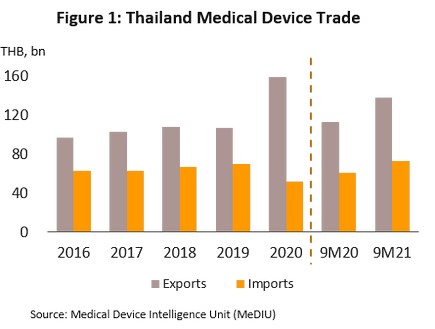
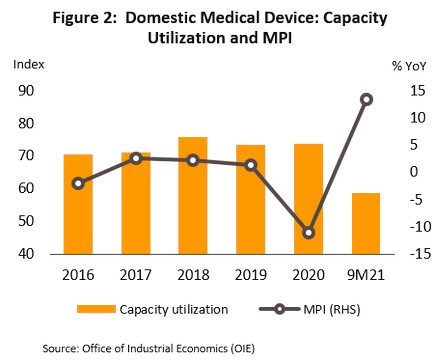
2022-2024 Outlook
- The outlook is broadly positive for the medical devices industry, and the forecast is for the value of goods distributed to domestic and international markets to grow at average annual rates of respectively 7.0% and 8.5%, though the latter will represent a slowdown from the very steep growth rates seen over 2020 and 2021. Sales will be boosted by a number of factors. (i) The aging of society will increase the number of people suffering from chronic NCDs. (ii) Demand from the main export markets will remain strong, especially for single-use devices such as latex gloves and syringes. (iii) Having crashed 97% in 2021, the number of foreign patients coming to Thailand for treatment will bounce back to growth over 2022-2024. (iv) Globally, concerns with health and wellbeing are rising. (v) Government policy to promote Thailand as an international medical hub. However, challenges will remain, including stiffening competition that will be caused by Thai operators’ limited abilities to develop advanced technology. This then forces the country to rely on imports or on overseas players setting up production facilities in Thailand.
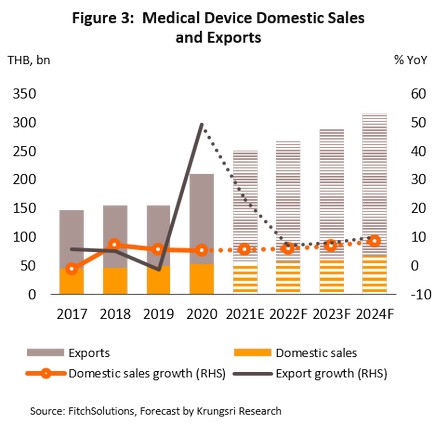
CONSTRUCTION & CONSTRUCTION MATERIALS
Construction Contractors
Situation in 2021
- Over 9M21, total investment on construction rose 5.0% YoY to THB 1,087.2bn. The public construction investment contributed THB 652.2bn of this (up 7.8% YoY), with spending rising for megaprojects including phase 3 of the work on Map Ta Phut Port (initial work on this began in July 2021) and continuing work on other sites. However, private construction investment rose just 0.9% YoY, hitting a total of THB 435.0bn, and depressed economic conditions and the need to close laborers’ accommodation to control the spread of COVID-19 meant that work on many private construction projects was postponed.
- In what remains of 2021, public construction investment will continue to rise (e.g., on the construction and repair of secondary roads in the provinces) but private construction investment will remain depressed as developers of properties for sale and rent continue to postpone work on new projects and instead try to run down their backlog of older stock. Thus, 8M21 applications for construction permits for residential segment, office buildings, and hotels were down by respectively 3.0%, 20.1% and 37.9% YoY. For 2021 overall, spending on construction is forecast to rise 5.3% to THB 1,385bn, split between THB 820.0bn (+7.7%) from the public sector and THB 565.0bn (+1.9%) from the private sector.
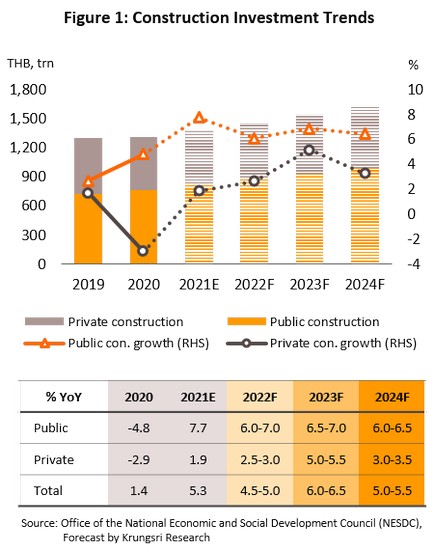
2022-2024 Outlook
- Investment on construction is forecast to rise 4.5-6.5% per year, driven principally by government spending on megaprojects, in particular those connected to the development of the Eastern Economic Corridor (EEC).
- Public construction investment is likely to increase by 6.0-7.0% as work on megaprojects linking to the EEC gets under way from 2022. These projects will include: (i) the high-speed rail-link connecting the 3 airports of Don Muang, Suvarnabhumi and U Tapao, with work initially beginning on the Suvarnabhumi-U Tapao section; and (ii) phase 3 of the development of Laem Chabang Port. In addition, important projects elsewhere in the country will include work on the passenger lounge for Terminal 2 at Suvarnabhumi Airport, the Bangkok-Nakhon Ratchasima high-speed railway, the Khon Kaen-Nong Khai dual-track railway, and the southern extension to the MRT Purple Line (Tao Poon-Rat Burana).
- Private construction investment will see a slow growth in 2022, but the situation should improve in 2023 and 2024, underpinned by: (i) an acceleration in government infrastructure projects that will induce the crowding-in effects in private sector; (ii) progress with the EEC development, which will feed into a pickup in spending on the construction of factories and industrial estates; and (iii) government measures to help stimulate demand for condominiums and houses.
- Large contractors continue to enjoy advantages compared to SMEs thanks to their stronger bargaining position relative to manufacturers and distributors of construction materials, their better ability to bid for contracts, and the greater openings available to them to expand into markets in neighboring countries. For their part, income for SMEs tends to come from sub-contracting for large players, meaning that business conditions can be uncertain. Contractors are also now exposed to risk from labor shortages due to the ongoing spread of COVID-19, though this is especially the case for smaller players.
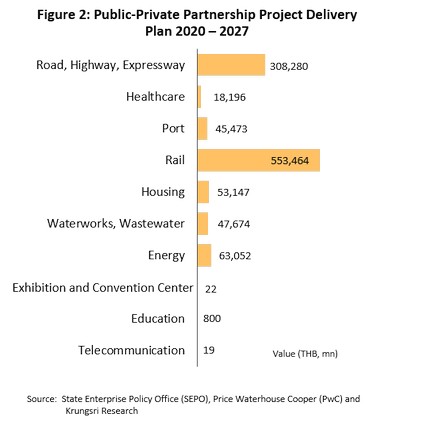
Construction Materials
Situation in 2021
- Over 9M21, output and domestic sales of construction materials strengthened in most product categories, driven largely by an increase in public-sector construction (in the period, government spending on this rose 7.8% YoY). In light of the latter, sales of cement (excluding clinker) and of construction steel (bar and section) rose slightly by 1.5% and 2.3% respectively, but continuing sluggishness in building by the private sector, and in particular in the residential segment, meant that the volume of ceramic tile and sanitary ware that were distributed slipped 1.7% YoY and 7.0% YoY, respectively. Thanks mostly to ongoing growth in government spending, demand for construction materials should continue to rise in Q4, but persistent weakness in private-sector construction will weigh on the market, and any overall growth in the output and domestic sales of building materials across 2021 would remain low.
- Exports performed well in 9M21, with overseas sales of cement (excluding clinker) up 13.7% YoY to 3.0m tonnes on stronger sales in the main markets of Myanmar, Australia and the US. Exports of construction steel also rose 10.9% YoY, with strong growth reported in major markets of Malaysia, New Zealand, and the Philippines. Imports jumped 14.8% YoY with recovery in the volume of domestic building work. Imports of ceramic tile and sanitary ware were also up 21.1% YoY in the period as suppliers rebuilt stocks in anticipation of recovery in the housing market next year, and with 95% of imports originating in China, imports of Chinese sanitary ware rose 23.0% YoY. Across the year as a whole, imports and exports of construction materials are therefore expected to strengthen from their level in 2020.
- The construction materials price index climbed 7.5% YoY in 9M21 on rising index of prices for steel and steel products (+30.4% YoY) that contrasted strongly with the 10.2% YoY slump seen in 9M20 (in line with changes in global steel prices). The increasing prices this year come from a fall in oversupply. For Q4, prices are forecast to remain elevated, and this will lift the construction materials price index by 7.0-9.0% for 2021 overall.

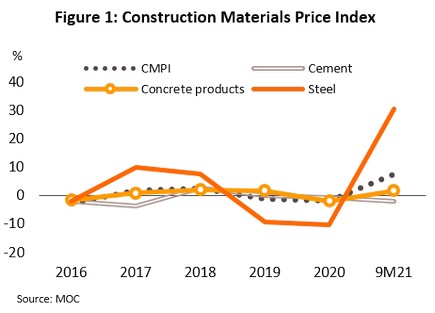
2022-2024 Outlook
- Domestic market: Demand will tend to strengthen thanks to the following.
- Government investment on construction will expand by 6.0-7.0% over 2022-2024 due to an acceleration of work on EEC infrastructure megaprojects, as well as progress with other infrastructure projects elsewhere in the country.
- Investment on construction by the private sector should recover with: (i) the crowding-in effect of higher government spending on infrastructure; (ii) progress on the development of the EEC, which will then help to speed up investment in factories and industrial estates in the area; and (iii) the effect of government measures to stimulate the real estate sector that aim to increase demand for condominiums and houses.
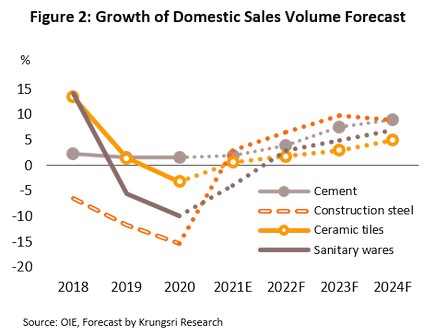
- Exports should see solid rates of growth. Overseas sales of cement and construction steel will benefit from greater investment in infrastructure by governments in neighboring countries (Thailand’s principal export markets). Exports of ceramic tile and sanitary ware will also tend to strengthen with growth in real estate markets, which will itself be boosted by Chinese investors looking for residential property, and a better outlook for markets for other commercial properties in the region.
- Construction materials prices: Overall, these will tend to edge up slightly on: (i) recovery in demand in the construction sector; (ii) the government’s policy of using Thai-made materials in public-sector construction[1]; (iii) the rising cost of imported raw materials (e.g., of scrap and billet), prices for which are escalating with those on world markets; and (iv) higher energy costs.
-
Traders:
- Modern trade outlets should see gradual growth in income, helped by the rising consumer preference for retailers that offer a comprehensive range of products. In the coming period, players will secure their positions by: (i) opening smaller outlets that will allow them to distribute into individual communities more effectively; (ii) partnering with manufacturers to open new types of outlet that meet demand from particular consumer groups; (iii) increasing the share of own-brand product lines, which will then cut costs and increase margins; (iv) developing new distribution channels that will include extending their online presence and use of mobile applications; and (v) investing in new branches across the ASEAN region.
- Traditional outlets will have to face conditions that will remain depressed, with overall business growth very limited. (i) traditional wholesalers, the market will remain flat or perhaps expand slightly, though players will have to contend with escalating competition from both modern trade operations and manufacturers that are distributing directly to contractors. (ii) Traditional retailers are overwhelmingly small operations, of which there is a large number, and these face limitations in terms of their access to capital and their ability to stock a wide range of products. Traditional retailers also face rising competition from modern trade outlets, while they are also hampered by their reliance on lower-income customers, who have been disproportionately affected by recent turbulence in the economy (i.e., rising unemployment, and wage and salary cuts). Given this, the outlook is for conditions to remain unfavorable.

Steel
Situation in 2021
- Output of hot-rolled coil (HRC)/hot-rolled sheet (the primary input into the production of flat steel products) rose 20.7% YoY to 2.2m tonnes in 9M21. Output was lifted by the restarting of production lines in downstream industries, in particular by auto assemblers and electrical appliance manufacturers. Having suffered in 9M20 from the COVID-19 outbreak, exports also performed well in the period, and for all of 2021, output of HRC is expected to jump 18.0-21.0%.
- Demand for HRC came to 5.3m tonnes in 9M21, up 44.0% YoY. Demand is expected to remain strong in Q4, and for 2021 overall, demand is forecast to increase 31.5% to 6.8m tonnes.
- 9M21 exports of HRC and hot-rolled P&O surged 325.1% YoY on strong growth in the Malaysian and Spanish markets (respectively 58% and 30% of all exports of HR sheet) and in Indonesia (responsible for 70% of exports of HR sheet P&O). Imports were also up, rising 68.5% YoY, in particular from Japan (the source of 91% and 74% respectively of imports of HR sheet and HR sheet P&O, for which imports were up 42.8% YoY and 41.2% YoY in the period).
- Prices for HRC also increased in 9M21, moving with global prices that were boosted partly by falling production in China (a response to environmental regulations). Prices thus leapt 69.3% YoY to THB 31,261/tonne, and these are expected to stay in the range THB 30,000-33,000/tonne for 2021 overall, significantly up from 2020’s level of THB 19,287/tonne.
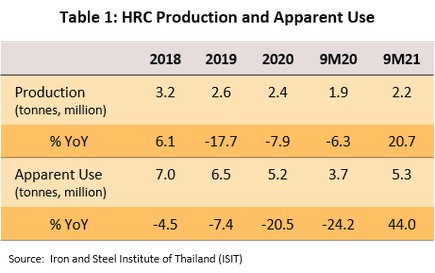
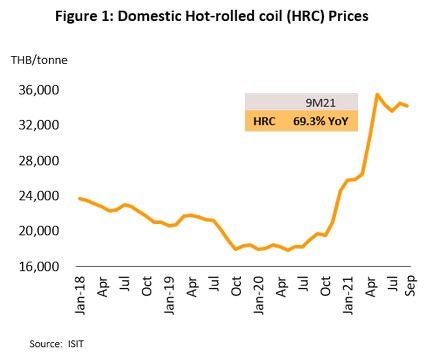
2022-2024 Outlook
- Output of HRC will continue to rise but because Thailand lacks domestic upstream steel suppliers, business costs will climb. Thai products will therefore be at a competitive disadvantage relative to imports, especially those from China, where suppliers are overhauling their production processes to provide the market with higher-quality low-cost goods.
- Demand for HRC will continue to strengthen from 2021 onwards, with this averaging some 7.5m tonnes annually. The main markets for HRC are in the auto and electrical appliance industries, and these are expected to improve with domestic sales recovery from rising consumer spending power and exports expansion from the better outlook for the global economy.
- Prices for HRC are expected to remain elevated on continuing strong demand. In addition, China is shutting polluting foundries and so Chinese output is likely to decline, while the authorities there have also cancelled tax rebates for most exports of steel products, and this will then help to reduce the impact of the supply glut that has been weighing on global markets. Given this, prices can be expected to strengthen.
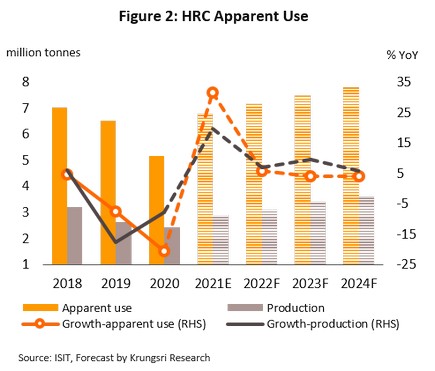
Situation in 2021
- Output of steel bar and section (the major products in the long steel product category) rose 1.6% YoY over 9M21, helped by recovery in the construction industry. For the year in total, output is expected to increase 2.3%.
- In 9M21, demand for steel bar and section increased 2.3% YoY to 2.8m tonnes. Stronger demand was driven by a pick up in activity in the construction industry (the main consumer of these products), and in particular by the 7.8% YoY increase in spending on public-sector construction. Demand for bar and section should continue to increase in Q4, helped by the government’s ‘Made in Thailand’ policy, which specifies that at least 90% of all construction steel (by volume or value) used in building projects carried out by state agencies or state enterprises must be Thai-made (public private partnerships are excluded from this requirement). Demand will be further helped by recovery in private-sector construction, which will rebound with an improving economic environment. Demand for 2021 is therefore forecast to rise 2.6% to 3.8m tonnes.
- 9M21 exports of bar and section also rose, increasing 10.9% YoY to 0.4m tonnes on stronger sales into the main markets of Malaysia, New Zealand and the Philippines. Imports were up 14.8% YoY on rising demand from the domestic construction industry.
- Prices of steel bar increased 52.7% YoY over 9M21, lifted by higher prices on global exchanges. For the remainder of 2021, global steel prices are expected to remain elevated and so average 2021 domestic prices should run in the range THB 25,000-27,000/tonne, up from THB 17,335/tonne in 2020.
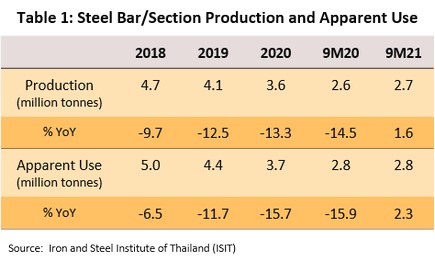

2022-2024 Outlook
- Over the next 3 years, demand should strengthen by an average of 4.0-5.0% per year, bringing demand to 4.0-4.4m tonnes/year. The market will be lifted by greater progress on government infrastructure projects, especially by the initial stages of construction (e.g., laying foundations and constructing the piers for elevated rail track). However, the oversupply of properties in some segments means that growth in private-sector real estate construction will be limited.
- Output is expected to rise by 3.0-4.0% annually, helped by the impact of the Made in Thailand program on purchases made by the public-sector, stimulus measures targeted at the real estate sector, and policies to encourage greater construction of factories and warehouses. However, Thai players will face strong competition from low-cost Chinese imports.
- Domestic prices for steel bar and section will tend to remain high in the coming period, lifted by the rising cost of inputs (i.e., of scrap and billet), the fall in Chinese production capacity and the subsequent easing of the supply glut, and what are likely to be high energy costs.
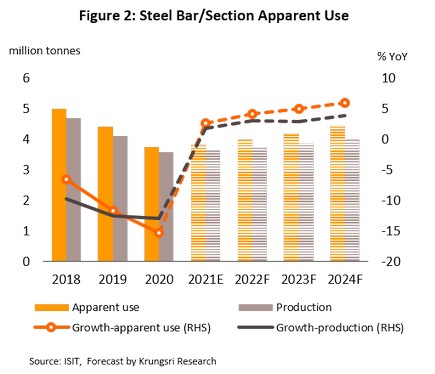
REAL ESTATE
Housing in BMR
Situation in 2021
- The housing market[1] in the Bangkok Metropolitan Region (BMR) continued to be badly affected by the COVID-19 crisis through 1H21, and this then cut the number of new supply by 18.8% YoY (down to 22,171 units). The supply of new low-rise developments was particularly hard hit, falling 34.0% YoY to 12,212 units. The supply of new condominiums actually increased 13.3% YoY to 9,959 units in 1H21. Despite an increase on a yearly basis. 1H21 new condominium supply was still substantially lower than the average for previous years. However, total pre-sales increased 32.9% to 34,065 units (from a 46.2% contraction in 1H20) helped by the stability of upper-income earners’ purchasing power, government stimulus measures that included cutting fees for registering mortgages and the transferring ownership, and extremely low interest rates.
- The housing market failed to recover in 2H21 because continuing economic weakness (especially in Q3) and high levels of household debt continued to weigh on demand. However, the Bank of Thailand’s relaxation of the LTV rules[2] helped to stimulate the market and to prevent too steep a contraction in demand. For all of 2021, sales are expected to remain similar to their 2020 level, though the number of new units coming up for sale will drop 17% (a continuation of 2020’s 41.6% slump); developers are tending to postpone work on new projects as they wait to see how the economic conditions evolves, and instead they are trying to run down stocks of unsold units.
- Increases in the housing price index[3] slowed in 1H21 relative to 1H20 as developers cut prices to encourage sales. For detached- and townhouses, the index rose 1.8% and 1.0% respectively (compared to 5.5% and 5.6% in 1H20). But the condominiums index was up just 0.7% (down from a 6.0% rise in 1H20). For 2021 overall, prices for residential properties will remain weak, especially in the condominium segment where developers are more focused on selling off their backlog of finished but unsold units.
2022-2024 Outlook
- The housing market in the BMR is likely to revive over the next 3 years with steady economic growth, an acceleration in work on megaprojects, the implementation of policies that will help to stimulate the real estate market (i.e., the relaxation of LTV rules and changes to the law to make it easier for non-Thais to own land and property in Thailand[4]), and increasing demand from expatriates working or investing in Thailand. However, recovery in the lower to middle range of the market is expected to be somewhat limited, while lenders will remain wary over releasing new credit, and so sales are expected to improve only slowly, rising to 74,000 units by 2024 (compared with average annual sales of 99,000 units over 2014-2019).
- New housing supply is expected to rise by some 14-15% annually, though developers will move to meet real demand and this will increase the share of new low-rise properties in the market to close to that of condominiums. Despite this strong growth, only around 80,000 new units are expected to come up for sale in 2024, still significantly lower than the average of around 100,000 new units coming to market annually over 2014-2019. In this environment, large developers will be able to sustain growth, but SME developers will face stiff competition over both the sale price of finished units and land suitable for development, which is becoming more expensive as supply shrinks.
- Low-rise housing (detached housing and townhouses): Home buyers are beginning to place a greater emphasis on properties’ usable space to support working from home, and so low-rise developments in more suburban areas are gaining in popularity. This trend is being helped by: (i) their low price compared to downtown areas, the ability of developers to split developments into different phases (unlike condominiums, which have to be completed in full before any units can be transferred); and (ii) the extension of metro lines into less central parts of Bangkok and the BMR.
- Condominiums: The market will improve in particular parts of the BMR, especially in downtown areas and near some metro lines. Most condominium projects are undertaken by large developers that are skilled in project management and marketing and that have access to sources of working capital, and so although new supply has slowed sharply in 2021, existing oversupply remains high in some areas, for example along the MRT Blue Line (Hua Lamphong-Bang Khae) and the Green Line (Bang Na-Samut Prakan). These, though, are remoter regions that have less appeal than other areas.
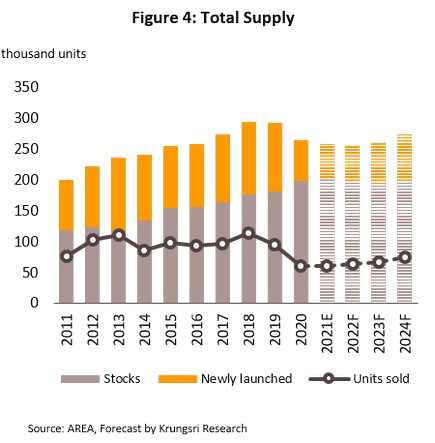
- In the coming period, by concentrating on a wider range of consumer needs, property developers are likely to broaden the types of project. These will then include mixed-use developments, wellness residences, properties for the elderly, and smart homes that are equipped with modern technology. Developers will also move more strongly into the leasehold market.
- Factors that may affect the market over the next few years include: (i) changing consumer preferences that, following the COVID-19 pandemic and the explosion in working from home, are now favoring larger, low-rise developments in more suburban areas; and (ii) alterations to the law that will make it easier for non-Thais to own land and property in the country.
Housing in Upcountry (major six provinces)
Situation in 2021
- The housing market in the 6 main provinces[1] remained extremely depressed in 1H21. In the period, the supply of new low-rise and high-rise units dropped by respectively 21.8% and 69.1%YoY, while overall sales slumped 27.6% on weak purchasing power, rising household debt (this hit 90.5% of GDP in 2Q21) and a tightening of the release of credit by lenders. Sales of low-rise thus slid 22.9% YoY while sales of condominiums were down a full 37.1% YoY, with markets in Chiang Mai (-79.7%) and Phuket (-45.7%) performing especially poorly.
- In 2H21, the market will remain sluggish on the continuing effects of the COVID-19 pandemic and slow recovery on consumer spending power and confidence. Developers are holding a significant stock of unsold property (around 83,000 units as of 1H21). Therefore, they will not be rushing to break ground on new projects. For 2021 as a whole, sales are expected to continue the decline recorded in 2020, and as a result, the ownership transferred will fall for both low-rise properties and condominiums.
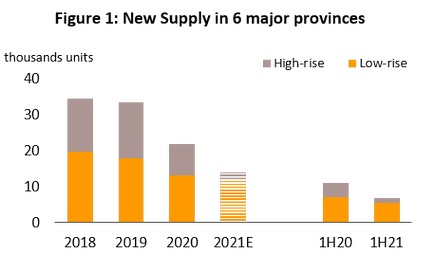
2022-2024 Outlook
Demand for property in the 6 provinces will tend to rebound over the next few years on: (i) regional economic recovery; (ii) stronger investment by the government in infrastructure upgrades, especially in the EEC, which will then help housing markets in Chonburi and Rayong to recover ahead of other provinces; and (iii) a recovery in the tourism market once vaccine rollouts have been completed. In addition, plans by the government to relax rules on the ownership of property by non-Thais[2] will also help to support stronger demand, especially in tourism or industrial provinces (e.g., the EEC).
- Low-rise housing: The supply of new low-rise properties is forecast to expand by an annual average of 4.5%. Housing purchase should rise from real demand and these tend to be mid- to upper-income earners. Demand will be helped by prices that remain relatively low, and by changes in behavior brought about by COVID-19 that are increasing demand for low-rise housing (rather than condominiums) since these have the space required when working from home.
- High-rise housing (condominiums): Recovery will be slower in this segment, and having fallen sharply in 2021, the supply of new condominiums is forecast to rise by an average of 2.5% per year. Supply will tend to increase in the EEC as developers look to meet rising demand from investors moving into the area, as well as in tourist areas (e.g., Phuket and Ko Samui) to meet demand that will be stoked by recovery in the tourism sector and by the relaxation of land-ownership rules for non-Thais.
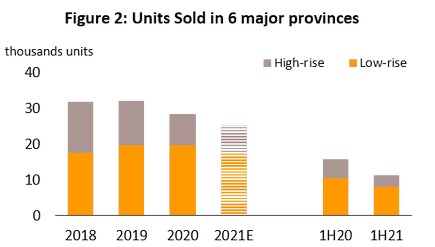

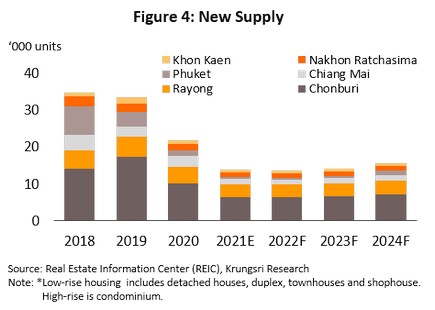
Commercial Buildings in BMR
Situation in 2021
- Over 1H21, the market for office space remained depressed. The worsening outbreak of COVID-19 and the fragile recovery in the Thai economy forced some businesses to abandon plans for expansion, reduce the size of their operations, or give up their leases completely. Landlords worked hard to hold back these trends and to keep their current tenants in place and even to attract new ones. Thus, rental prices tended to weaken, especially for Grade-B Non-CBD, and overall, total demand for office space slipped by just 0.6% YoY, falling to 8.3m sq.m. in the period. At the same time, supply increased 2.5% YoY to 9.4m sq.m., bringing the occupancy rate down to 88.7% from 91.6% in 1H20.
- Through 2H21, supply continued to expand while demand remained depressed and so for 2021 overall, the occupancy rate is expected to fall to 88% from 2020’s 91%. Rental rates for Grade-A properties have tended to hold up on persistently strong demand from renters active in parts of the economy that have enjoyed solid growth through the COVID-19 crisis (e.g., technology platform companies and e-commerce). However, renters of Grade-B units mostly are SMEs, which have seen incomes fall from 2020 onwards, and so rents for these properties have softened through 2021.
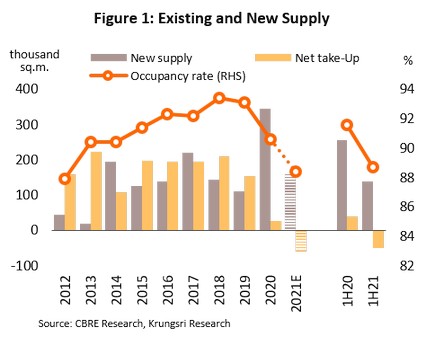
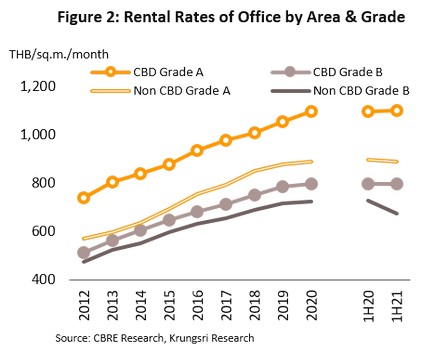
2022-2024 Outlook
- The market is expected to grow by 1.5% p.a. over the next 3 years, supported by economic recovery at home and abroad coupled with an acceleration in spending on the buildout of new infrastructure by the Thai government, and this will encourage developers to invest in new properties and the renovation of existing units in both CBD and Non-CBD locations. Demand would come from businesses active in services, trade and technology, while supply will be extended in line with developers’ pre-existing plans, especially for the development of mixed-use projects, including Siamscape, Unicorn Park Silom, Empshere, and One Bangkok (Phase 1), though labor shortages will likely result in work on some projects being pushed back. Over 2022-2024, 800,000 sq.m. of new office space is due to be completed, increasing supply by 2.6% annually. The occupancy rate will weaken to around 86%; the greater range of choices available to renters will mean that their market position will strengthen, and as such, rents will increase at a slower rate.
- Developers in the CBD will be able to maintain healthy profits, especially for Grade-A properties since these are in limited supply and occupancy and rental rates remain higher than elsewhere. But for Non-CBD locations or in outer parts of the BMR, income will remain flat or fall. Many developments are small projects undertaken for the developer’s own use, with units in these then let out. There is a significant supply of these types of property, most of which are Grade-B units, and so competition is high. Developers will thus attemp to keep existing renters in place and to attract new tenants, and it is difficult for them to raise rents
- Expanding supply will tend to feed stronger competition. Even after the COVID-19 abates, some office workers are likely to persist with working from home for years, and this will tend to undermine demand for office space and to drive up competition. As developers plan to double investment in office space over 2022-2024, and demand will strengthen only gradually, this will leave little space for developers to increase rents.
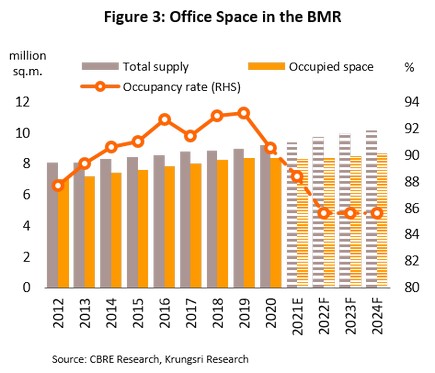
Situation in 2021
- In 1H21, the supply of new retail space in the BMR came to just 83,000 sq.m. and with the COVID-19 crisis continuing to weigh on supply, growth was significantly below the levels seen for the same period in previous years. The total supply of retail space[1] thus rose 1.7% YoY to 6.52m sq.m., while the total occupied retail space stood at 6.1m sq.m. (up 0.2% YoY). This then reduced the average occupancy rate to 94.4% from its 1H20 level of 95.8%, though operators used pricing strategies to keep tenants in place.
- In 2H21, the fragile economic recovery and the continuing effects of COVID-19 meant that many retailers postponed plans for expansion or reduced their retail footprint, and these trends helped to restrict the expansion in new supply to just 17,000 sq.m. For the year overall, demand for rented retail space will likely be down 2.5% YoY, but although work on some projects has been postponed due to labor shortages, supply has continued to expand in line with pre-existing plans, and this is thus forecast to have increased by 1.6% YoY to 6.53m sq.m.
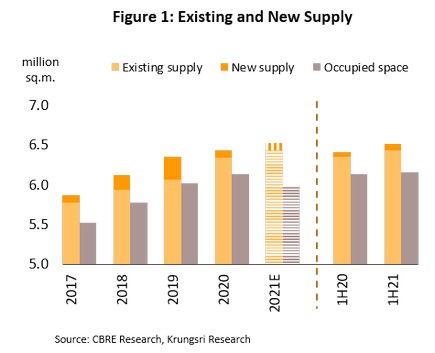
2022-2024 Outlook
- The business environment should improve with recovery in private-sector consumption and progress by the government on its buildout of new infrastructure, this then helping to stimulate stronger investment in retail. Over the next 3 years, demand for rented retail space is expected to rise at an average rate of 3.0% per year. Developers have plans to add over 800,000 sq.m. to supply annually, adding 3.7% to supply each year. The growing gap between supply and demand will bring the occupancy rate down to 90%, and in some areas, rents can also be expected to fall.
- Enclosed malls: Demand is recovering slowly and so income will increase only slightly. Sites in downtown locations are constrained by limited opportunities for expansion and so to better meet consumers’ changing lifestyles, operators will instead focus on investing in the modernization of properties. Rental rates will thus tend to increase only marginally.
- Community malls: Income will tend to remain flat. Because these developments have a relatively small footprint that imposes fairly low investment overheads, while plots suitable for development are easy to find, supply will increase in the coming period. However, shoppers in community malls tend to come from low- to mid-income groups, and for these consumers, recovery will be a drawn-out process and demand growth will be limited. This will then impact sales for renters of space on community malls, making it difficult for landlords to raise rents.
- Supporting malls: Overall income will remain low. Supply growth will accelerate over 2022-2023, which will then pull down occupancy rates, with negative effects on rents.
- Providers of brick-and-mortar retail space are coming under increasing pressure from growth in e-commerce, and continuing development of online sales may begin to erode demand for store space. At present, online distribution represents just 3-4% of all retail sales, but online channels have the potential to grow rapidly in the coming period and landlords will need to overhaul their business models to stay ahead of changing consumer behavior.
Industrial Estate
Situation in 2021
- In 1H21, sales and leases of land on industrial estates slipped 13.2% YoY to 659 rai. The decline was particularly strong in the eastern region (down 29.5% YoY) due to the outbreak of COVID-19 and the subsequent need to impose a lockdown. This then weighed on sales and transfers, 75% of which are in the east of the country.
- With regard to supply, 5 new industrial estates opened in 1H21. These had a total area of 6,191 rai. All of these were in the eastern region, with 3 in Chonburi (4,185 rai) and 2 in Rayong (2,006 rai). This concentration is, however, in keeping with the 56.6% YoY increase in the value of projects located in the eastern region that were approved for BOI investment support, this fact reflecting the region’s (and in particular the EEC’s) potential to support continuing industrial expansion. As of 1H21, Thailand was home to 65 industrial estates, spread across 16 provinces, and combined, these covered 168,000 rai, 77.7% of which was in the East. Total the area of land that had been sold or leased on industrial estates nationwide came to 129,000 rai, or 76.9% of total supply.
- For 2H21, demand for land on industrial estates is expected to have remained depressed on a combination of the only slow recovery and the repeat waves of COVID-19 infection globally. Companies have thus been holding back on new investments, and so for 2021 in total, sales and leases of industrial estate land is forecast to fall 15.4% from its 2020 level to just 1,100 rai.
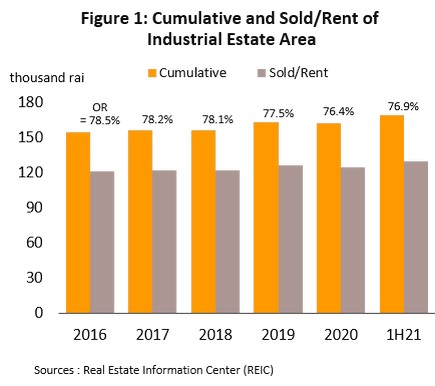
2022-2024 Outlook
Total sales and leases of land on industrial estates is forecast to jump by 35.0-37.0% to 1,700, 2,300 and 2,800 rai in each of the next 3 years. This outlook is supported by: (i) recovery in the global economy that will increase confidence among overseas investors and lift Thai exports; and (ii) greater progress by the government on the build-out of new infrastructure, in particular in the EEC. Operators will also likely increase the share of income coming from the supply of services and utilities, and to reduce their dependency on income from sales and leases (which fluctuates with movements in the economy overall). In addition, players will tend to increase investments in the development of ‘smart parks’, i.e., industrial estates that are fitted out with modern technology in the areas of production, transport, communication, and energy, and in environmentally friendly industrial estates that are ready to support future industries.
- Eastern region: Demand for space would grow at a healthy pace, helped by government spending on the infrastructure required to support the EEC. Given this, operators in the East will enjoy income growth that will significantly outpace that of other parts of the country. Nevertheless, rising prices and the difficulty in finding land suitable for development will restrict the ability of players to expand existing operations or to set up new operations.
- Central region: Demand will continue to grow at a good rate thanks to the area’s transport links. Operators will thus enjoy solid rates of income growth, especially from rents and the supply of services and utilities.
- Other regions: Demand will remain depressed for land on industrial estates elsewhere in the country as long as government action to stimulate greater interest from private-sector investors (especially spending on infrastructure in and near SEZs) is lacking. Players will thus see a slow
HOSPITALITY
Hotels
Situation in 2021
- The hotel industry remained severely depressed through 9M21. The worsening outbreak of COVID-19 forced the government to introduce strict control measures that then caused a 98.7% YoY collapse in tourist arrivals. Total arrivals thus numbered just 86,000 in this period, with the 5 most important markets being the US, the UK, Germany, China and France. At the same time, domestic tourism slumped to 27.6m trips (down 48.9% YoY), and these two trends pulled down the occupancy rate for the period to just 10.0%, compared to 28.5% in 9M20. As a result, room rates fell 20.1% YoY, depressing the RevPAR further from its 9M20 level of THB 323 to a historic low of THB 90 (-72.2% YoY).
- In the remainder of 2021, the industry will benefit from the rising number of people who are fully jabbed and by the relaxation of government controls. (i) From 1 November, the country reopened to quarantine-free arrivals from 63 low-risk countries (though with some conditions). (ii) The curfew has been lifted nationwide and 17 provinces (including Bangkok) have been designated pilot provinces for the period 1-30 November, with another 33 added for 1-31 December. (iii) The government has put in place stimulus measures aimed at the tourism sector, including phase 3 of the We Travel Together program (24 September, 2021 - 31 January, 2022) and the Tour Tiew Thai program (8 October, 2021 - 31 January, 2022). Nevertheless, prospective tourists are still cautious about travel, and policies in some originating countries continue to restrict outbound travel. The hotel industry will thus remain depressed, and for all of 2021, foreign arrivals are expected to number just 350,000 (-94.8%), while domestic tourists are predicted to make 52m trips (-42.5%), and this will keep occupancy rates at 14.0%, compared to 29.5% in 2020.
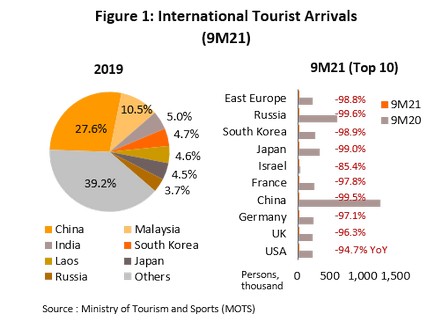
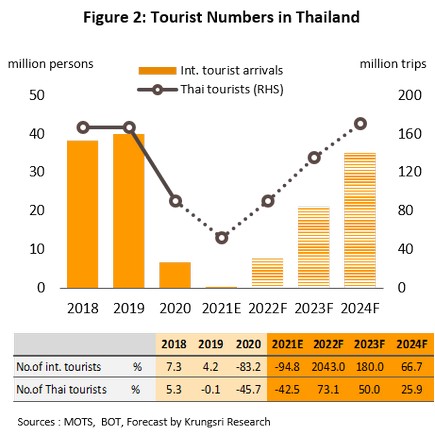
2022-2024 Outlook
- The hotel industry will recover with the easing of the COVID-19 crisis due to the success of vaccination programs leading to the increase in domestic and international tourism. Foreign arrivals are thus forecast to reach 7.5m in 2022, 21m in 2023, and 35m in 2024, before returning to their pre-COVID level of 39-40m in 2025. Helped partly by government support for the industry, domestic tourism will recover ahead of this, and the domestic segment is expected to hit its pre-COVID level of 170m trips in 2024. Alongside this steady recovery, hotel occupancy rates will tend to improve gradually, rising to 35% in 2022, 45% in 2023, and 60% in 2024.
- Hotels in major tourist destinations (Bangkok, Pattaya, and Phuket): Incomes will begin to recover in 2022, and occupancy rates should average 60% by 2024.
- Hotels in tourist destinations and regional centers: Income would recover over 2023-2024 with the rebound in domestic tourism, helped by government support for the industry.
- Hotels in other provinces: Incomes will recover only slowly and occupancy rates are likely to remain low since most hotels in this group serve travelers on their way to important regional centers or tourist areas. There is thus a significant possibility of players, and especially SMEs, going out of business.
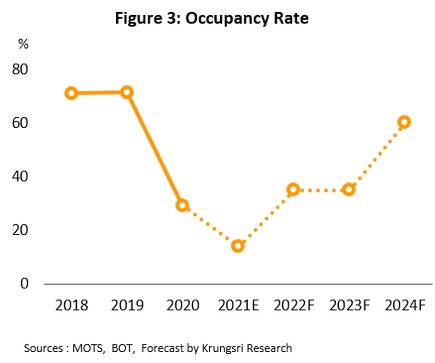
Private Hospitals
Situation in 2021
- Over 9M21, income for private hospitals grew on the higher number of in- and outpatients as a result of the severe outbreak of COVID-19 and the sharp rise in caseloads, (over 20,000 new cases per day). Hospitals also benefited from services associated with the pandemic, such as testing, vaccinating, and running ‘hospitels’ in cooperation with outside business partners, and from the expansion of their customer base to include patients covered by health insurance. Nevertheless, some domestic patient groups either canceled or postponed visits to hospitals for non-urgent treatments, and this caused income from complex treatments (e.g., for cancer and heart disease) to fall. The government’s decision to allow some overseas patients to enter the country for treatment helped to partially offset these losses, but overall, the continuation from 2020 of restrictions on international travel meant that income from this segment remained depressed.
- For the rest of 2021, the sector will benefit from the relaxation of control measures and the boost that this has given to economic activity generally, as well from the move by the government to allow hospitals to inject their vaccines of choice, and from November, the reopening of the country to international arrivals. As a result of the latter, foreign patients will now be able to seek treatment in Thai private hospitals. For 2021 overall, income for players should increase by 8.0-10.0%, after 12.0% drop in receipts in 2020.
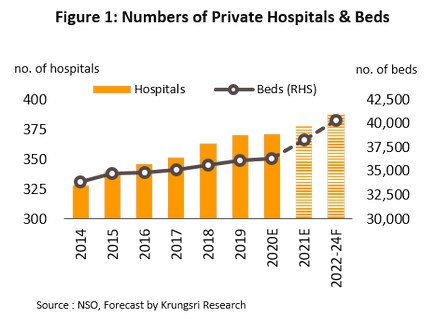
2022-2024 Outlook
The outlook is expected to improve steadily to average 4.0-5.0% per year through the next 3 years. At least 2,000 beds will be added to the current supply of around 36,000 beds in private hospitals (as of 2021).
- Demand for hospital services would strengthen on the following factors:
- Structural Thai society is steadily aging, driving greater demand for ongoing and complex treatments. The authorities thus estimate that spending on healthcare for the elderly will rise from THB 63bn in 2010 to THB 230bn in 2022.
- The number of foreign patients seeking treatment in Thai hospitals will increase due to: (i) the gradual reopening of the country to foreign arrivals in provinces where at least 70% of the population are vaccinated; and (ii) Thailand’s position as a world leader in the provision of medical tourism services.
- Thais are increasingly concerned with personal health and wellbeing, boost by the COVID-19 pandemic and the need for comprehensive healthcare.
- Operators are expanding their investments in services, site expansions, and in the manufacture of goods related to healthcare in order to increase their competitiveness, to deepen supply chains, and to establish a broader range of business partnerships at home and abroad. Meanwhile, the government is working to promote Thailand as an international healthcare hub, partly by specifying ‘comprehensive healthcare’ as one of the new S-curve industries. It is hoped that this will then attract greater investment into private hospitals, especially in the EEC.
- Large hospitals: Income will rise at a good rate due to their abilities to treat a wide range of patients and to provide specialist, highly skilled services. Players also operate large branch networks and partner with outside businesses, helping them to expand their services by better targeting particular patient groups. Given this, large hospitals’ income base will broaden in the coming period.
- Small and mid-sized hospitals: Turnover will trend upwards, supported by (i) benefit from partnering with the large players; and (ii) group of patients covered by social security payments; which helps to provides a steady source of income. Nevertheless, strong competition may cause independent hospitals operating outside wider commercial networks to lose market share.
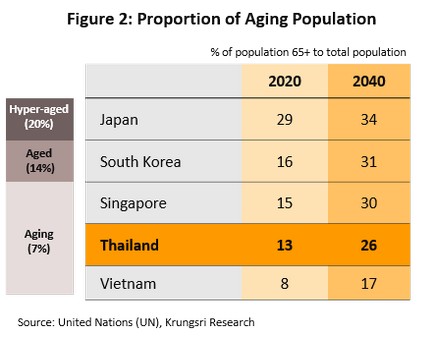
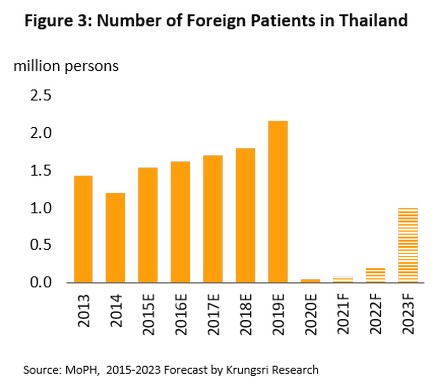
RETAIL TRADE
Modern Trade
Situation in 2021
- Modern trade sector remained depressed over 9M21, and this was reflected in both the drop in July’s retailer sentiment index to a 16-month low and the continuing slide in the consumer confidence index. Nevertheless, the relaxation of control measures (i.e., the gradual winding down of the curfew and the extension of department store opening hours) through August and September helped businesses to rebound. This process was then helped further by the reopening of the country to foreign arrivals at the end of the year and the boost that this will give to overall recovery in consumption.
- In Q4, sales will improve for operators of discount stores, hypermarkets, supermarkets, and convenience stores. Nevertheless, for all of 2021, total sales across the modern trade sector will still be down by between 5.5% and 6.5%, though this will be an improvement on 2020’s 12% contraction.
2022-2024 Outlook
Income should return to growth of around 2.0-3.5% per year, This outlook is supported by the following considerations.
- Domestic purchasing power will recover in the coming period with recovery in the economy, the latter helped by: (i) government stimulus measures and spending ; (ii) a rebound in the tourism sector and in spending by tourists, with arrivals forecast to reach 7.5m in 2022, 21m in 2023 and 35m in 2024; and (iii) economic growth in the CLMV region that will help retailers in border areas.
- Players will shift their business strategies by expanding their customer base and building new income streams over the long term. Future developments will thus include: (i) increasing online sales alongside offline operations; (ii) forming business partnerships with operators in other industries, e.g., in logistics; and (iii) expanding branch networks, especially in Bangkok, tourist areas, and second-tier provinces, as well as in the EEC and border regions. In addition, major players will tend to increase investments in neighboring countries, where markets show significant potential.
- Growth trends for income for each segment are given below.
- Department stores: Following an anticipated fall of 7.5% in 2021, income is expected to grow by 2.0-3.5% annually on domestic economic recovery that will then lift spending power. Investments will tend to be made in high-potential provinces and in overseas markets.
- Discount stores: Income will decline 6.0% in 2021, but the segment should return to growth of 1.5-2.8% per year. The customer base for discount stores typically comprises low- to middle-income earners who shop for daily necessities, but competition on price within the segment is stiff, while players also need to compete with other parts of the modern trade sector (e.g., convenience stores).
- Supermarkets: Income should increase by an average of 2.8-4.7% annually (which will be a turnaround from 2021’s projected fall of 6.0%), helped by the spending of targeted consumers, who are generally mid- to upper-income earners.
- Convenience stores: Income is forecast to slip 6.6% in 2021 but then to bounce back to growth of 1.7-3.5% annually on the extension of branch networks to cover almost the entire country.
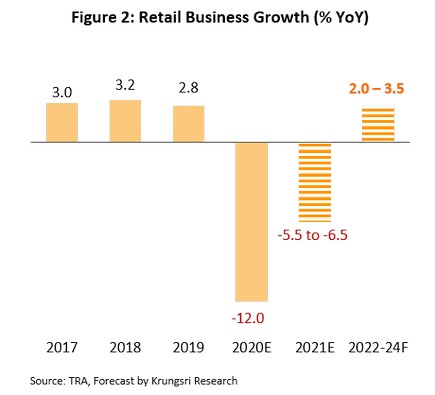
FINANCIAL SERVICES
Credit Card
Situation in 2021
- Total credit card spending dropped 4.8% to THB 1,218.1bn in 9M21, with a 0.3% YoY fall in outstanding balances. Naturally, overall spending was heavily impacted by the COVID-19 pandemic and the effects of this on overall income and expenditure, as well as by the shrinkage of the tourism sector and the rise in household debt to 89.3% of GDP. But spending continued to increase in areas including insurance, online shopping, top-ups to e-wallets, food, games, streaming services, and household goods and decorations. Meanwhile, growth in the number of cards issued slowed to 2.6% YoY as issuers became more careful about the release of new credit.
- Credit card spending will bounce back in Q4, helped by progress with vaccinations and the relaxation of control measures since the end of Q3 that has allowed many parts of the economy to return to life. In addition, many parts of the country have reopened to international arrivals, while domestic shoppers will be incentivized to spend by the government’s ‘We Travel Together’ and ‘Shop and Refund’ programs. The result of this will be that for all of 2021, credit card spending should be down by just 1.0-2.0%.
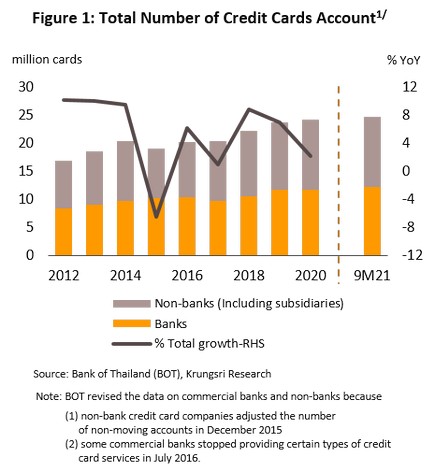
2022-2024 Outlook
- Over the next 3 years, the combined value of credit card payments is expected to rise by an average of 6.0-7.0% per year, supported by a return to economic growth and, now that vaccine programs are reaching a large share of the population, recovery in the tourism sector. Beyond this, the industry will also benefit from changing consumer behavior, in particular the growing preference for making payments through electronic means and for shopping online with growing E-commerce that help boost spending.
- Operators will be careful about issuing cards to new customers, and to reduce exposure to risk that may arise from continuing uncertainty over the pandemic and the escalation in household debt, they will generally restrict expansion only to high-income earners and high-potential consumer groups. This will then help issuers hold off rises in operating costs, which might occur if they need to increase reserves to set against bad debts.
- Competition will tend to stiffen in the coming period as both traditional financial institutions and non-banks try to expand into the market for making online payments; this remains an important strategy for gaining access to future customers.
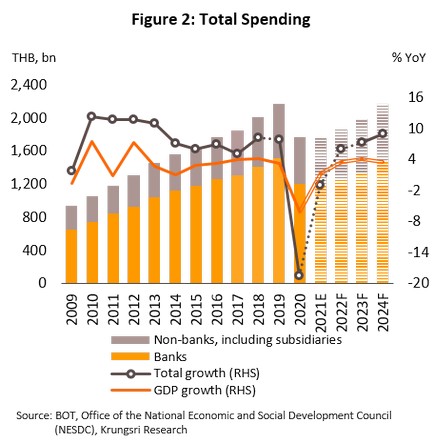
OTHER SERVICES
Mobile Communication
Situation in 2021
- Over 9M21, sectoral income slipped 1.1% YoY, with operators’ average revenue per user (ARPU) down by 3.0-5.0%. Revenue has suffered under the impacts of softening consumer spending power, the contraction of the tourism sector, and the need to temporarily shut service centers as part of the shared efforts to control the spread of COVID-19. In addition, price competition between operators has been stiff as players try to offset weakening purchasing by poaching target customer groups from one another, and this has kept prices in the low-level. Nevertheless, the industry has benefited from a number of factors, including the surge in working from home and online study, growth in e-commerce and consumption of internet-delivered services, greater uptake of data services, and the extension of 5G networks, all of which has then helped to prevent too rapid a decline in income.
- In the rest of 2021, income from services should improve in step with the general rebound in economic activity and in particular with the November reopening of the country to foreign arrivals, which will help service providers expand their overall user base. For 2021, income from services should thus either remain unchanged or weaken by up to 1.0%, an improvement from 2020’s decline of 3.2%.
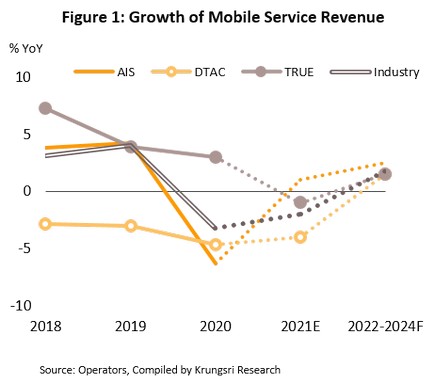
2022-2024 Outlook
The mobile telecoms sector will return to growth, with income from services forecast to rise by an average of 2.0-3.0% per year,supported by:
- Demand for services will tend to strengthen: (i) the economy and consumer spending power gradually recover. Also, the reopening of the country to foreign arrivals will feed into a rise in the number of pre-paid customers. Service providers will also run campaigns to encourage users to move to monthly accounts, which will then tend to increase income; (ii) Demand is rising for mobile data services, i.e., using mobile phones to access the internet, consume entertainment, use social media, carry out financial transactions, and buy and sell goods and services. (iii) Widespread digitalization of many of economic sectors (e.g., of retailing, manufacturing, and transport and distribution) will increase demand for connecting to the internet of things (IoT) through mobile networks; and (iv) Government policies including the promotion of the digital economy, the development of smart cities, and the allocation of 5G frequencies will ensure that mobile telecoms infrastructure extends across Thailand (5G networks are now available in all 77 provinces), and this will help to stimulate stronger demand from consumers in new parts of the country.
- Service providers will increase investments in extending networks and developing additional services to expand their subscriber-base and increase income streams over the long term, such as developing platforms to support digital enterprises, widening their corporate userbase, providing specialist network services to 3rd parties, and forming business partnerships with players in, (e.g. finance, retail and public health). Alongside this, though, price will likely be more competitive, costs will rise due to network expansion investment to bid for access to network frequencies.
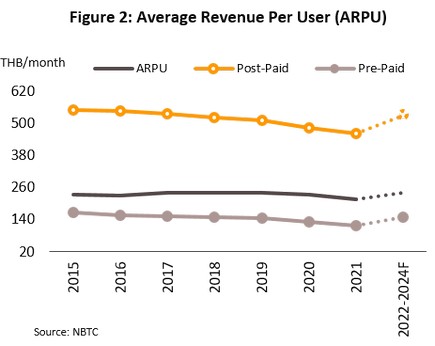

Logistics
Situation in 2021
- Following the restarting of production lines, the warehousing industry continued to grow from 2020. The economic outlook improved for many countries through 2021 thanks to the success of vaccination programs and the reopening of borders and economies, which then stimulated growth in imports and exports to rebuild inventories and meet rising demand. In addition, the domestic imposition of social distancing measures, the closure of department stores and shopping centers, and the increase in working from home all also fed into a surge in online shopping, which added to demand for warehouse space for stockholding and distribution. For all of 2021, demand for warehouse space is therefore forecast to rise by 3.3% YoY to 5.05m sq.m., from 3.5% in 2020.
- Supply increases have been constrained by the significant glut of unoccupied rental properties and periodic outbreaks of COVID-19, which has then slowed investment targeted at anticipated new demand. Most expansion in supply that has occurred has thus been in the form of ‘built to suit’ projects for existing customers that had already planned for business expansion. For 2021, total supply of rented warehousing space is expected to increase by 2.3% YoY to 5.96m sq.m., which would then represent a slowing of 2020’s 2.7% expansion in supply. The relatively weaker expansion in supply relative to demand will then raise the occupancy rate, bringing this up from 83.9% in 2020 to an anticipated 84.7%. However, rents will remain broadly unchanged from a year earlier.
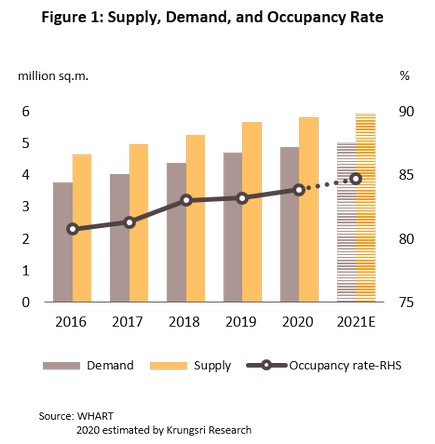
2022-2024 Outlook
- Over the next 3 years, demand is forecast to grow at an average rate of 3.5% per year, supported by: (i) economic recovery, which will feed into stronger manufacturing and trade, and rising exports and consumption; (ii) an acceleration in government spending on infrastructure megaprojects that will increase demand for warehouse space in new locations; and (iii) the rising popularity of online shopping, which is stoking stronger demand for rental space to use for storage and distribution.
- Supply is forecast to expand by around 3.0% annually, or 180,000 sq.m. This growth will be driven partly by progress on the development of new industrial parks and estates, customs-free zones, and warehouse farms. These will tend to be built by property developers and major operators of industrial estates, and will be constructed as modern, integrated warehouses that are ready to be fitted out with digital technology appropriately. Most new construction will be in the BMR, the EEC, regional centers, and border provinces that are well served by transportation links that connect them to urban areas, neighboring countries or on to southern China. However, rather than renting, some businesses are switching to building their own warehousing, and this will push warehouse operators to take a cautions step to expand their investments, especially while much warehousing space remains unoccupied. Because demand will rise faster than supply, the occupancy rate should strengthen to 85-86%.
-
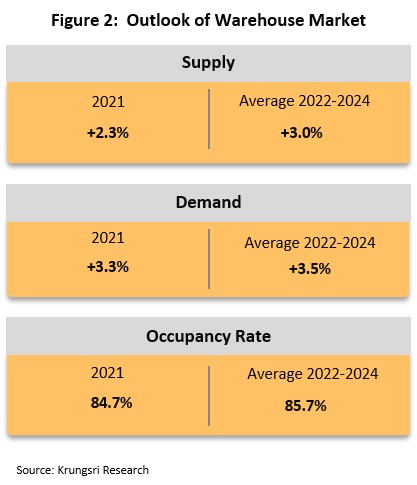
-
Mass Rapid Transit Operators
Situation in 2021
- Over 9M21, operators of mass transit systems became loss-making. (i) Income from passengers slumped with the drop off in ridership, consequence of the COVID-19 outbreak, especially during the peak travel months of January and April, and the government’s strict control measures. These included the closure of department stores and entertainment spots, the imposition of a curfew, an increase in working from home, the switch to online study, and social distancing measures, which then led operators to limit crowding and restrict operating hours. (ii) Income from the rental of commercial sites and advertising space also slipped, with operators having to cut rents to keep leaseholds active.
- BTS: Average ridership slumped 48.2% YoY to 203,597 trips per day with social distancing rules, an increase in working from home, the shift to online study, and the almost total disappearance of tourists from Bangkok, especially of Chinese visitors (accounted for 5-6% of all trips, source: BTS).
- MRT: The number of trips dropped 44.8% YoY to 137,667 per day. The need to impose control measures meant that business activities were severely impaired, and this caused a sharp drop off in travel from suburban to downtown areas.
- ARL: Ridership dropped 48.3% YoY to 20,735 trips per day. A ban on outbound and inbound travels in several countries and in interprovincial travels in the country when infections were at their worst meant that the number of passengers passing through Suvarnabhumi Airport fell steeply. This was particularly for foreign travelers, who had comprised 20-30% of ARL users.
- For the remainder of 2021, daily ridership is expected to average 557,895 trips/day, compared to 361,999 trips/day in 9M21. Take up of services will be lifted by the relaxation of control measures, the shortening of the curfew, the ability to run at full capacity, the reopening from October of the country to international arrivals, and the opening in November of 37.6 kilometers of new track on the Red Line (Bang Sue-Rangsit and Bang Sue-Taling Chan). For the whole year, passenger numbers would still contract 41.7% for the BTS, 40.4% for the MRT, and 48.1% for the ARL, from a drop by respectively 40.8%, 22.6%, and 43.0% in 2020.
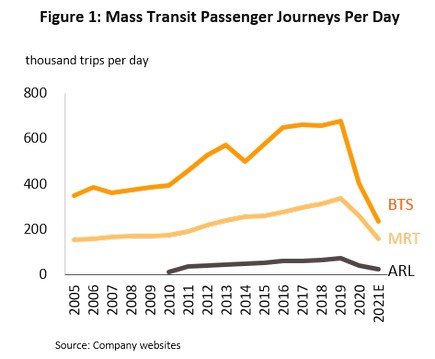
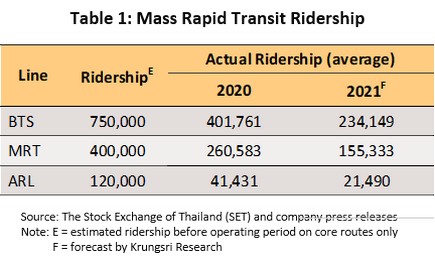
2022-2024 Outlook
- Ridership is forecast to rise to 600,000-650,000 trips/day with mass vaccination program and the full reopening of the country. Passenger numbers will also increase with: (i) the rebound in economic activity; (ii) the number of people living in new condominium buildings built along mass transit routes, or close to stations or station interchanges; and (iii) the opening of new lines extending existing operations, and the increase in the number of park and ride facilities, which will help to increase the number of passengers traveling between suburban and inner-city areas.
- Over the next 3 years, 3 major new lines (with a combined length of 84.4 kilometers) will help to increase travel in outer regions of Bangkok. (i) On the Pink Line (Khae Rai-Minburi) is scheduled for opening in mid-2022 followed by the Sri Ratch-Muang Thong Thani extension at the end of 2024. (ii) On the Yellow Line (Lat Phrao-Samrong) will open in July 2022. (iii) On the Orange Line (East) (Cultural Centre-Minburi) is expected to open at the end of 2024. Operators will benefit from additional income from both higher passenger numbers and the management of new commercial spaces, the management and maintenance of train and communication equipment, and from contracting for state organizations (e.g., for the BMTA, MRTA, and the SRT Electrified Train).

Situation in 2021
- The shipping industry enjoyed sharp rates of income growth in 9M21, and this was reflected in increases in the Baltic Dry Index of 221.7% YoY and in the Howe Robinson Container Index of 284.3% YoY. Prices index were lifted by: (i) an improving economic outlook for Thailand’s major trade partners (the IMF sees 2021 global growth hitting 5.9%, with world trade volume up 9.7% in the year) that then spurred significant additional demand for raw materials and final goods; and (ii) the impact of COVID-19 on port facilities, with labor shortages leading to a slowdown in velocity utilization of goods handling and storage that then delayed the reloading of containers and caused a significant extension to wait times for ships queueing up outside ports in preparation for offloading cargo. The shortage of containers and of shipping capacity will persist through the remainder of 2021, thus keeping cargo rates elevated.
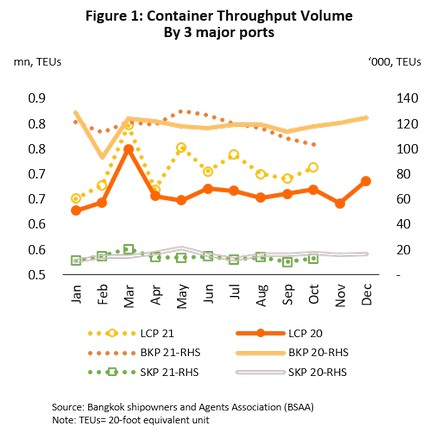
2022-2024 Outlook
- Over 2022-2024, economic recovery in export markets will support rising demand for maritime services. Stronger demand for goods will have a positive impact on shipping and container services, helping to keep freight rates high through 2022, though these will likely begin to soften in 2023 and 2024. The industry will benefit from the following: (i) The IMF sees global growth of 4.9%, 3.6%, and 3.4% over each of 2022, 2023 and 2024, while UNCTAD predicts growth in the volume of global seaborne trade rising 3.2%, 2.4% and 2.3% over the next 3 year. (ii) Strict COVID-19 controls will slow the delivered new cargo ships. BIMCO estimates that the supply of space of container ships is expected to increase by 3.2% annually, while for bulk shippers, supply will rise by 2.9% per year, with new build ships entering service from 2023 onwards. (iii) The periodic need to impose checks and tighten procedures to contain the spread of COVID-19 may delay the offloading of cargo. At the same time, demand will remain strong and so although they will likely soften over 2023 and 2024, shipping fees rate charges will remain high.
- The cost of oil, a major contributor to overall operating costs, is expected to remain high, but stronger demand for low-sulfur bunker oil will push up prices, the high charges that shippers will be able to impose will mean that the impacts of this will be limited.
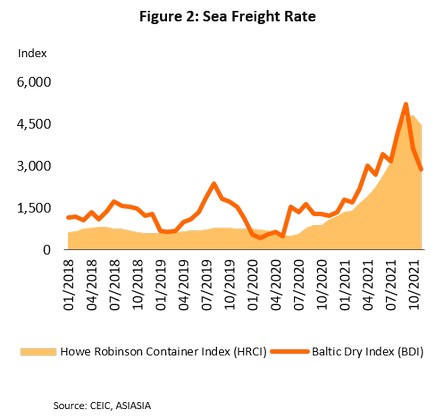
Digital services and software
Situation in 2021
- The Digital services and software industry continue grow by 16.0-17.0% in 2021, having jumped 22.3% in 2020. The growth has mainly been seen in the digital services and other following segments.
- Digital services: Income leapt 25.1%, boosted by the lockdown instituted in response to the COVID-19 outbreak, and surge in working from home, which pushed consumers and organizations to operate through online platforms. The highest rates of growth were reported in the e-retail and e-logistics segments, followed by online media with the widespread switch to consuming news and entertainment through online channels.
- Software and software services: Income slowly increased by 2.4%, mostly driven by the provision of software consultancy services related to customized software designed for large corporations, but new software investment continued to slowed down in line with economic conditions.
- Digital content: Income edged up 5.0%, driven by growth in the market for mobile/tablet games. Most notable has been growth in cloud gaming that uses AR/VR, attracting new gamers during WFH. Increases in income from animation and character design remains limited by the restricted demand for these services.

2022-2024 Outlook
- The industry should see strong rates of growth by 9.0-10.0% as businesses increasingly switch to digital transformation as a means of adding value.
- Digital services: Income should rise by 11.0-12.0%, helped by: (i) government plans to achieve full national 5G coverage by 2022; and (ii) changing patterns of work and consumption that increasingly rely on the use of digital platforms. The fintech sector will also grow with the increasing popularity of e-wallets, though stiff competition with the high number of players.
- Software and software services: Income should rise by 7.0-8.0%. (i) Private sector players will increase investment in software and cloud solutions as businesses recover and look to better meet individual consumer needs through online channels. The government also encourages the digital transformation of SMEs by offering tax rebates for spending on software (ii) Government agencies are reforming their internal operations by delivering a greater share of their services online and/or through apps.
- Digital content: Income would increase by 7.0-8.0% driven by growth in demand for games on smart technology devices, helped further by the rollout of 5G networks that boost speed of new cloud-based games and will attract new players. Income of animation and characters will improve, though not at a particularly impressive rate since economic conditions in countries that buy in these services (especially in Japan) are forecast to improve only gradually.
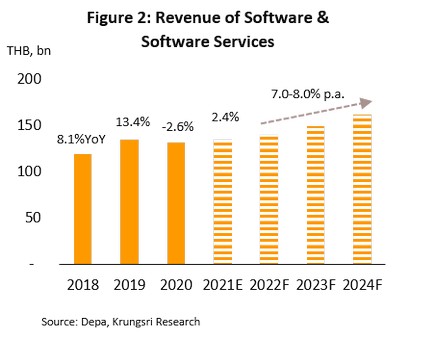
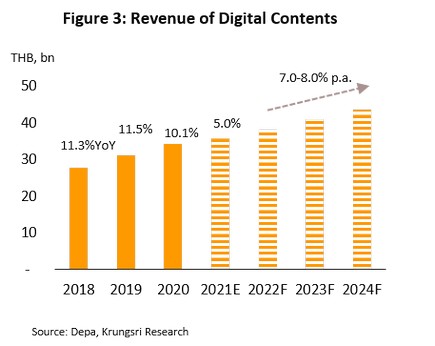
[1] This is enforced once ratified by a sufficient number of signatory nations, that is, at least 6 ASEAN nations and 3 non-ASEAN nations
[2] The combined value of goods and service value chains in RCEP member states represents 26% of the entire global supply chain. Midstream products are particularly well represented in this total, these having grown rapidly in value in RCEP countries (within these value chains, trade in midstream products grew by 50% over 2010-2018). The 5 most important industries in these value chains are: machinery and electronics, petroleum and chemicals, steel, textiles and apparel, and auto parts. These accounted for 60% of the value of regional value chains, with machinery alone representing a 37% share of the global value chain (from a seminar given by The Thai Shippers’ Council).
Note: Cannabis: The production, distribution and possession of cannabis is permitted as of 14 September, 2021, though only for medical uses.
Hemp: The production, distribution and possession of hemp is permitted as of 29 January, 2021, in the event that: (i) its use facilitates the work of a state organization; (ii) use of hemp fiber is part of a traditional activity, festival or way of life, and its consumption is limited to the grower’s family (families may grow up to 1 rai of hemp each); (iii) it is being used in a commercial or industrial application; (iv) it is being used in a medical application; (v) it is being used in research or for breeding; or (vi) it is being used to produce certified seeds. .
Kratom: The production, sale, purchase, possession, and consumption of kratom is permitted as of 24 August, 2021, under The Narcotics Act (No. 8) B.E. 2564 (2021) and as per the 2021 Kratom Act, though the organic law on the production, sale, use and control of kratom has yet to be published in the Royal Gazette (this should happen in 4Q21 or 1Q22). The legalization of kratom use should now lead to the development of supply chains and new industries that add value to the product in upstream processes (growing kratom), midstream industries (processing and extraction), and for related downstream industrial consumers (e.g., food processors, beverage producers, and manufacturers of medicines).
Chilled, Frozen and Processed Chicken
[1] Exported chicken carcasses typically weigh 2.6-2.7 kilograms, but the closure of processing plants led to the weight of chickens increasing to 3-4 kilograms each.
Power Generation
[1] This does not include 2,920 MW of power from large-scale hydro.
[2] Costs are around THB 1.81/unit compared to retail prices of THB 3.60/unit
Oil Refineries
[1] Diesel products include high-speed mineral diesel (B7, B10, and B20) and the basic diesel mix.
[2] Gasoline products include benzene (ULG95), gasohol 91, gasohol 95, E20, and E85
Pharmaceuticals
[1] A survey by the Office of Industrial Economics shows that the majority of domestic producers manufacture and distribute generic drugs.
[2] The Pharmaceutical Inspection Co-operation Scheme (PIC/S) is a cooperative framework set up by GMP inspectors from a number of countries (especially in Europe) that wished to establish universal standards for assessing GMP in pharmaceuticals production. Thailand officially became its 49th member on August 1, 2016.
Chemical Fertilizers
[1] This refers to local prices for urea (46-0-0), ammonia sulfate (21-0-0), and the fertilizer mixes 16-20-0, 15-15-15, 16-16-8, and 13-13-21, which comprise a combined total of more than 90% of the domestic fertilizer market.
Used-car Dealerships
[1] Lenders and the Bank of Thailand jointly issued regulations on debt holidays for auto loans that covered both the principal and interest of loans for a period of up to 3 months or 3 payments. This had effect from May-December 2021 and applied to: (i) those affected by the COVID-19 pandemic; (ii) debts that were not classified as NPLs (i.e., they were not more than 3 months in arrears) as of 1 March, 2020; and (iii) debts with an outstanding balance of not more than 90 days or 3 payments as of the day of registration. Lenders had the right to consider debts in light of the impacts of the Covid pandemic on individual borrowers, and then to charge a fee (at a rate decided by the lender) for any deferral of debt payments.
Integrated Circuits (IC)
[1] On-premises data centers are used to run data storage servers on a company’s own premises. This makes data storage more secure but at the same time, costs are higher than for running on-cloud data centers (renting server space from cloud computing operations and using this for data storage) since on-premises operations need to have equipment installed, maintained and upgraded (both hardware and software) every 3-5 years.
Construction Materials
[1] The government’s ‘Made in Thailand’ policy specifies that by volume and value, at least 90% of construction steel used in public-sector construction projects should be Thai-made (public-private partnerships are exempt from this requirement).
Housing in BMR
[1] Total housing projects include detached houses, townhouse, condominium.
[2] These changes raised the ceiling on the value of these loans (the LTV ratio) to 100% of the value of the loan’s collateral (i.e., mortgages may temporarily be taken out that cover the full value of the property being purchased) when these loans are for the purchase of a house, or when the loan is for other purposes but it is secured against a property, or it is a top-up loan. This applies when: (i) the value of the collateral is less than THB 10m and the loan is being made for a second (or more) home; or (ii) the value of the collateral is greater than THB 10m, and the loan is being made for a first (or more) home. These rules will be in effect between 20 October, 2021, and 31 December, 2022.
[3] The Combined Housing Price Index aggregates the cost of purchases of detached houses, townhouses and condominiums, and is calculated from the value of the collateral against which home loans have been issued by 17 Thai banks for purchases of properties in the BMR.
[4] As per a cabinet resolution of 14 September, 2021, options for reform are currently being researched.
Housing in Upcountry (major six provinces)
[1] The 6 provinces are Chiang Mai, Chonburi, Khon Kaen, Nakhon Ratchasima, Phuket and Rayong.
[2] Amendments to the law on property ownership by non-Thais are still in the process of being researched, as per the cabinet resolution of 14 September, 2021.
Retail Space
[1] Retail space comprises three segments - enclosed mall, community mall and supporting mall.
Private Hospitals
[1] BCG’s Center for Customer Insight
Credit Card
[1] One reason for the reduction in the number of issued credit cards in 2015 was that the Bank of Thailand had adjusted down its record of issued credit cards because (i) non-bank issuers had stopped counting ‘inactive accounts’ from December 2015, and (ii) commercial banks had stopped issuing certain types of credit cards from July 2016.





.webp.aspx)



























































































































